I Doped Like Maria Sharapova And It Was Actually Pretty Great



This site is made possible by member support. 💞
Big thanks to Arcustech for hosting the site and offering amazing tech support.
When you buy through links on kottke.org, I may earn an affiliate commission. Thanks for supporting the site!
kottke.org. home of fine hypertext products since 1998.
Entries for August 2017
Jerry Before Seinfeld
On September 19, Netflix is airing Jerry Before Seinfeld, a comedy special about how the world’s richest comedian got his start.
(BTW, Netflix is killing it this fall. Without having to seek anything out specifically, I already have at least 5 things I want to watch on there between now and November…not counting the backlog.)
Euclid’s Elements of Geometry done in a modernist Swiss Style

From Kronecker Wallis, the folks who brought you this reissue of Newton’s Principia, comes a new edition of Euclid’s Elements designed in a modernist Swiss Style.
Euclid’s Elements has been referred to as the most successful and influential textbook ever written. It was one of the very earliest mathematical works to be printed after the invention of the printing press and has been estimated to be second only to the Bible, in the number of editions published since the first printing in 1482.
The Elements is a mathematical treatise consisting of 13 books attributed to the ancient Greek mathematician Euclid. It is a collection of definitions, postulates, propositions (theorems and constructions), and mathematical proofs of the propositions. Elements is the oldest surviving large-scale deductive treatment of mathematics. It has proven instrumental in the development of logic and modern science.
The design and implementation of the book is based off of Oliver Byrne’s edition of Elements from 1847, of which Megan Mulder of the Z. Smith Reynolds Library writes:
Byrne’s Euclid is admired as much for its surprisingly modernist design and color palette — which seems to anticipate Bauhaus and De Stijl — as for its innovative pedagogy.
I have a copy of their Principia reissue (it’s beautiful), so I’m looking forward to this one.
100 Great Works of Dystopian Fiction
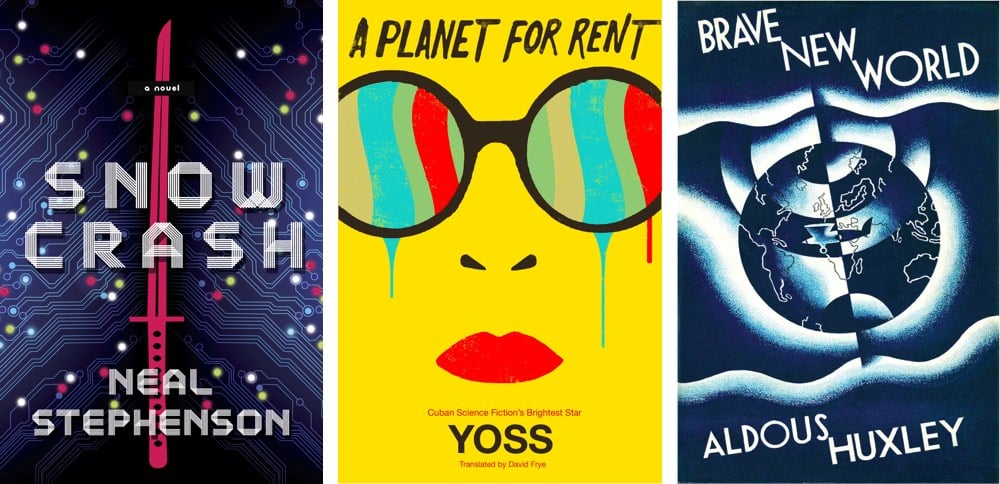
Vulture has compiled a list of 100 Great Works of Dystopian Fiction, “tales about a world gone wrong”. Entries on the list include some of the earliest examples like Mary Shelley’s The Last Man and The Time Machine by H.G. Wells, classics like Huxley’s Brave New World and 1984, modern classics like Snow Crash by Neal Stephenson and William Gibson’s Neuromancer, and some newer books like On Such a Full Sea by Chang-Rae Lee and A Planet for Rent by Cuban author Yoss. Even Infinite Jest makes an appearance. As does It Can’t Happen Here, a 1935 novel by Sinclair Lewis that sounds particularly relevant right now:
As the old saying goes, “history doesn’t repeat itself, but it does rhyme” — and Lewis’s It Can’t Happen Here is proof. This 1935 satire chronicles the career of fictitious U.S. politician Buzz Windrip, a populist senator who wins the presidency. As it turns out, he’s a bit of a fascist, but more frightening than his actions is the speed — and eagerness — with which Americans join him in his authoritarian crusade. Lewis understood the American soul better than most, and he makes a compelling case that fascist tendencies would make a horrifyingly good fit for our polity if presented with the right amount of good, old-fashioned patriotism.
See also a reading list for the resistance.
Newly processed photos of Jupiter taken by NASA’s Juno probe
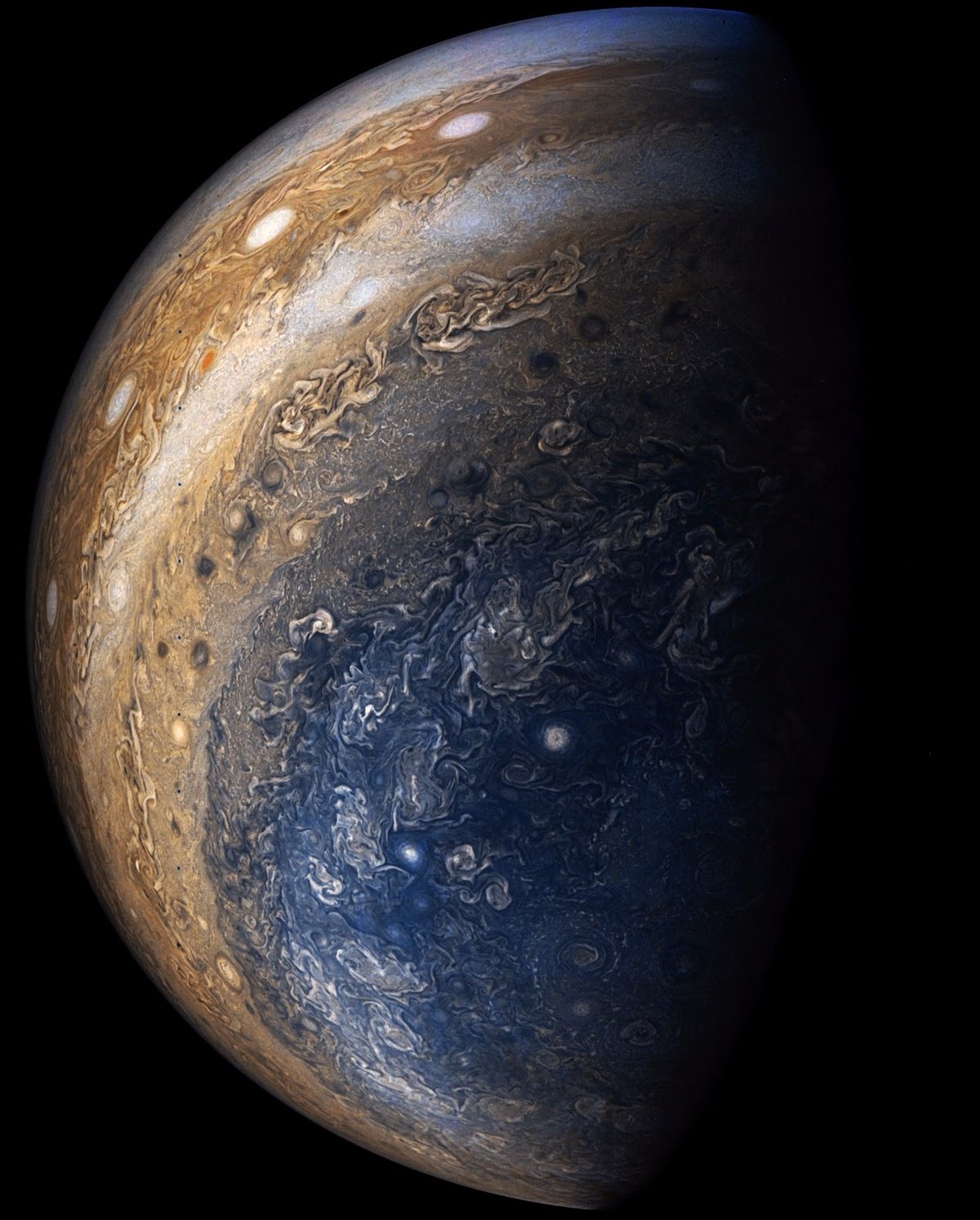
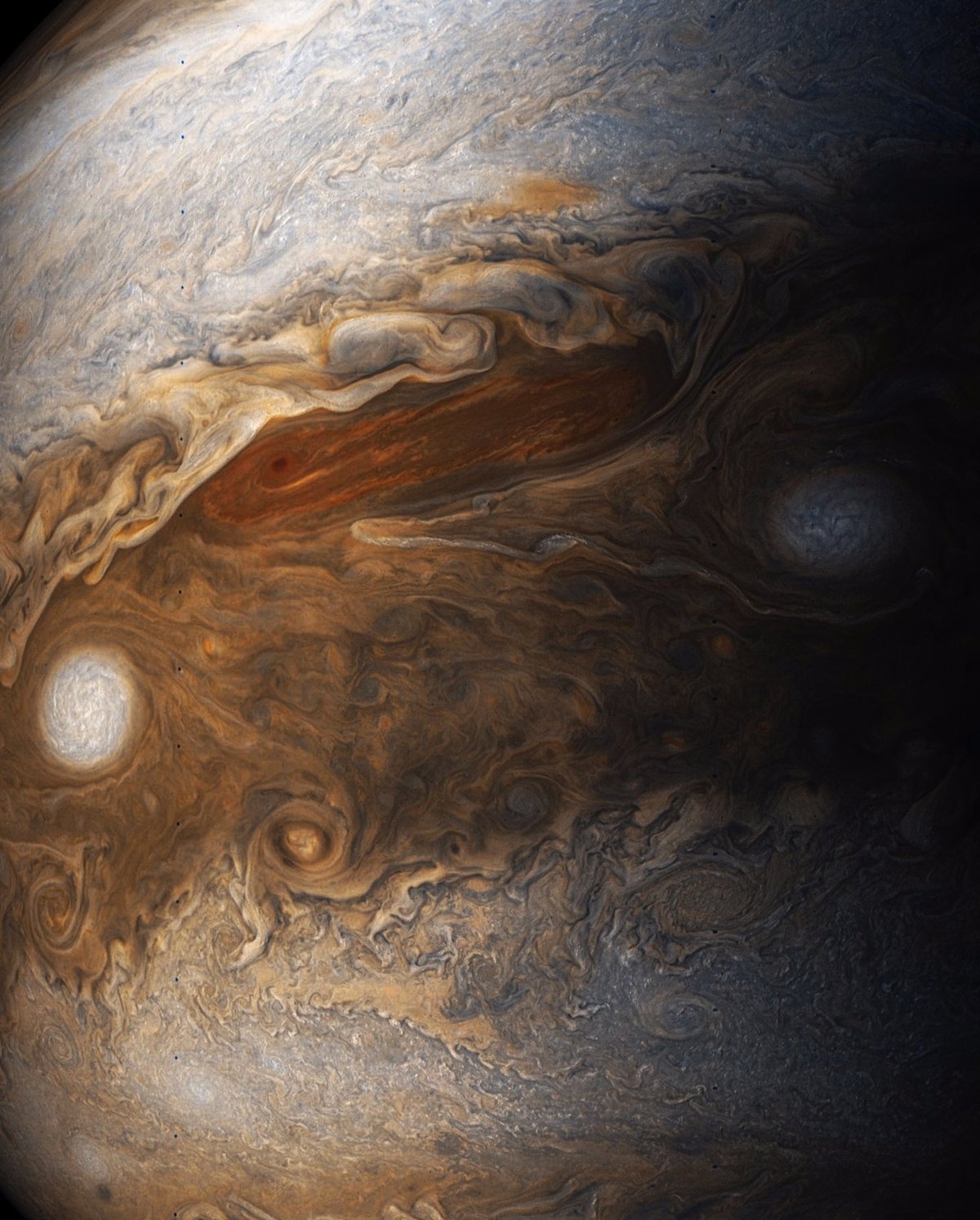

Seán Doran shared some recently processed photos of Jupiter that he worked on with Gerald Eichstädt. The photos were taken by NASA’s Juno probe on a recent pass by the planet. These are like Impressionist paintings…you could spend hours staring at the whirls & whorls and never find your way out. There are more images of Jupiter in Doran’s Flickr album, including this high-resolution shot that you can download for printing.
“The ability to behave randomly can be a great asset.” The human ability to produce randomness peaks at age 25.
Disturbed by on-field violence, top football TV analyst quits
Former NFL player Ed Cunningham has resigned from his job as a college football color analyst for ABC/ESPN because of “his growing discomfort with the damage being inflicted on the players he was watching each week”.
If Ed Cunningham had not already seen enough, he would be back in a broadcast booth on Saturday afternoon, serving as the color analyst for another top college football game televised on ABC or ESPN. It is the work he has done each fall for nearly 20 years.
But Cunningham, 48, resigned from one of the top jobs in sports broadcasting because of his growing discomfort with the damage being inflicted on the players he was watching each week. The hits kept coming, right in front of him, until Cunningham said he could not, in good conscience, continue his supporting role in football’s multibillion-dollar apparatus.
Another domino falls. Unless there are big changes to the game play, sooner or later football will likely become a marginalized sport in the US.
Politically, who played the Game of Thrones best in season seven?

The amount of media coverage of Game of Thrones was a touch too much this summer, but this ranking of the political strategies of the main players in season seven by Zack Beauchamp was both entertaining and informative. I mean:
To understand Cersei’s success, we need to reach back to the classic work of Prussian military theorist Carl von Clausewitz.
Before looking at the list, I’d assumed Jon Snow would get lower marks (he left the North vulnerable and cratered his coalition’s chances at a truce with Cersei), but Beauchamp makes a good case here.
I’ve argued before that the best way to think about the White Walkers, from the human point of view, is as a threat akin to climate change — a massive collective threat that humans were ignoring in favor of petty internal squabbling. Jon, to his immense credit, is the only leader who recognized the enormity of the threat early enough to try to rally others to stop it. He’s kind of a Westerosi Al Gore, only he succeeded in getting to run a country.
So the best way to think about Jon’s mission is through the lens of environmental diplomacy: He needed to convince the world’s leading powers to abandon the internecine struggle over the throne and refocus on the White Walker threat. He didn’t have a ton to work with: The North is a distinctly third-tier power, weaker militarily than both the Targaryen and Lannister alliances and the country most vulnerable to the White Walkers.
Jon may have failed to rally Cersei to his cause, but he succeeded in bringing on Daenerys. And that’s by far the most important, mostly because her dragons and cache of dragonglass represent the only chance humanity has at fending off the White Walker threat. If it weren’t for Jon, humanity would be fundamentally doomed.
French Resistance spy Jeannie de Clarens dies at 98
WWII spy Jeannie de Clarens died last week in western France at the age of 98. While working as an interpreter for a group of businessmen in occupied France during World War II, de Clarens passed information about German V1 & V2 rockets to the British government.
Getting wind of a secret weapons project, she made it her mission to be on hand when the topic was discussed by the Germans, coaxing information through charm and guile.
“I teased them, taunted them, looked at them wide-eyed, insisted that they must be mad when they spoke of the astounding new weapon that flew over vast distances, much faster than any airplane,” she told The Washington Post in 1998. “I kept saying, ‘What you are telling me cannot be true!’ I must have said that 100 times.”
One officer, eager to convince her, let her look at drawings of the rockets.
Most of what she heard was incomprehensible. But, blessed with a near-photographic memory, she repeated it in detail to her recruiter, Georges Lamarque, at a safe house on the Left Bank.
In London, intelligence analysts, led by Reginald V. Jones, marveled at the quality of the information they were receiving from Paris, notably a startling document called the Wachtel Report. Delivered in September 1943, it identified the German officer in charge of the rocket program, Col. Max Wachtel; gave precise details about operations at the testing plant in Peenemünde, on the Baltic coast in Pomerania; and showed planned launch locations along the coast from Brittany to the Netherlands.
Relying on this information, the British organized several bombing raids against the plant, which delayed development of the V-2 and spared untold thousands of lives in London.
As punishment for her resistance, de Clarens was held by the Germans in camps until near the end of the war. Total hero. (thx, kathryn)
How climate change makes hurricanes like Harvey worse
How anthropogenic climate change affects single storms like Hurricane Harvey is difficult to say. But from climate data, a couple of things about hurricane trends are clear. While the overall number of hurricanes will decrease due to the effects of climate change, the number of severe hurricanes, those causing the most damage, will increase. And the storms will also be wetter and, when combined with rising sea levels (also caused by climate change), will result in more coastal flooding and damage like we’re seeing now with Harvey.
See also Houston is experiencing its third ‘500-year’ flood in 3 years. How is that possible?
Climatologists say the mechanism by which this is happening is fairly straightforward. “Warmer air can contain more water vapor than cooler air,” according to the 2014 Climate Assessment produced by the U.S. government. “Global analyses show that the amount of water vapor in the atmosphere has in fact increased due to human-caused warming. This extra moisture is available to storm systems, resulting in heavier rainfalls.”
The Blade Runner 2049 backstory
The original Blade Runner was set in 2019, so 30 years have passed since then by the time the action picks up in Blade Runer 2049. While I imagine some of what happened in the interim will be covered in the new film, too much exposition is a narrative killer. So the filmmakers are releasing three short films that fill in the 30 year gap. The first one is set in 2036 and focuses on Niander Wallace, a character from Blade Runner 2049 played by Jared Leto.
In 2023, government authorities legislated an indefinite “prohibition” on replicant production, as a year prior a massive EMP detonated on the West Coast and is pinned on Replicants. So in this Wallace piece, we’ll see the beginnings of the new Replicants that are created after the prohibition is lifted.
At Comic-Con earlier in the year, a Blade Runner timeline was shown to fans:
2018: After a bloody mutiny by a Nexus 6 combat team in an Off-world colony, Replicants are declared illegal on Earth — under penalty of death.
2019: A prototype Replicant, Rachael, and Officer Rick Deckard, a Blade runner, escape Los Angeles together.
2020: After the death of founder Eldon Tyrell, the Tyrell Corporation rushes a new line of Nexus 8 Replicants onto the market for use Off-world. Unlike previous Nexus models, built with 4-year lifespans, the Nexus 8s have open-ended lifespans, as well as ocular implants for easy identification
2022: The Blackout. An EMP of unknown origin detonates somewhere in the West Coast. Cities are shut down for weeks. Electronic data is corrupted or destroyed over most of the United States. Finance and trade markets crash worldwide. Food supplies become dire. Theories spread as to the cause of the Blackout; none are proven. The most popular blame Replicants.
2023: Replicant Prohibition. The governing authorities legislate an indefinite “prohibition” on replicant production. Nexus 6 models are now all decommissioned due to their programmed 4-year lifespans. Surviving Nexus 8 models are to be retired. Those that can, go into hiding.
2025: Idealistic scientist Niander Wallace pioneers advancements in genetically modified food and shares his patents for free, marking an end to a global crisis. His company, Wallace Corporation, E&C, expands across the globe — and into the Off-world colonies.
2028: Niander Wallace acquires the remains of the bankrupt Tyrell Corporation.
2030s: Niander Wallace improves upon Tyrells’ genetic engineering and memory implantation methods to make replicants obedient and controllable.
2036: Prohibition is repealed. Wallace reintroduces a new line of “perfected” Replicants — The Nexus 9.
Early 2040s: The LAPD commits additional resources to bolster its existing Blade Runner unit, tasked with locating illegal Replicants and retiring them.
2049: When we return to Los Angeles, 30 years after the original movie, climate change has caused the sea level to rise dramatically. A massive Sea Wall has been built along the Sepulveda Pass to protect the Los Angeles basin. Los Angeles is even more uninhabitable than before and filled with poverty and sickness. Humans, who were not well enough to leave for the off-world colonies are left behind. There is no fresh food, and inhabitants survive on Wallace’s genetically modified food products sold from vending machines at street markets.
I’ll include the other two short films here as soon at they’re posted. (thx, david)
Update: The second short is out, starring Dave Bautista (Drax from Guardians of the Galaxy) as a replicant on the run.
Update: The third short is out; it’s animated by Shinichiro Watanabe of Cowboy Bebop.
Errol Morris’ new Netflix series, Wormwood
True crime OG Errol Morris has teamed up with Netflix for a 6-part series called Wormwood. The series is an exploration of the CIA experiments with LSD in the 1950s and the death of CIA employee Frank Olson, who was covertly given LSD more than a week before he died. Olson’s death was ruled a suicide, but many years later, the US government settled a potential wrongful death lawsuit out-of-court with a $750,000 payment to the family.
The show itself is a mixture of documentary and historical reenactment (starring Peter Sarsgaard & Bob Balaban) that is now somewhat standard in the true crime genre, having been pioneered by Morris in The Thin Blue Line. Of the show, Morris writes:
Isn’t journalism the pursuit of truth? But what if the truth proves to be elusive, hard to get at? How far does one go? Where does one stop? Are there limits, emotional and otherwise, to the pursuit of truth? Can it be injurious to one’s health? Here we have the story of one man’s sixty-year quest to identify the circumstances of his father’s death. Did he jump from a hotel window? Or was he pushed? And if he was pushed, why? What for? A shadowy world of hidden and imagined intentions coupled with dark and horrifying revelations. In many ways, a personal family story, but in many other ways, a story of America’s decline in the period following World War II. It asks the question: To what extent can a democracy lie to its citizens and still, in the end, remain a democracy?
On Netflix on December 15.
Update: Here’s the full trailer for Wormwood:
My recent (and not-so-recent) media diet
Quick reviews of some things I’ve read, seen, heard, and experienced in the past few weeks. As always, don’t take the letter grades so seriously. Somehow it’s been almost two months since my last installment?
Paterson. I would pay to watch Adam Driver read the phone book and that’s kinda what this is so I was satisfied. (B)
Despicable Me 3. I have a soft spot for the Minions movie (don’t know why, afraid to ask myself) but not for this one. (C+)
Cars and Trucks and Things That Go by Richard Scarry. This was my favorite book to read to my kids, but both of them can read by themselves now, so this is perhaps the last time I will get to sit down and read it with them and oh no I’m crying right now. (A+)
Mr. Holmes. This could have been good but 24 hours after watching, I’d forgotten everything about it. (C)
Spider-Man: Homecoming. My brain let out a big ol’ “ohhhhhh” after I realized two-thirds of the way through where they got the title. (B)
The Defiant Ones. Great. But I felt Dre’s apology for his violence against women was lacking. As with many apologies from the wealthy and powerful, it had more to do with him than with his victims. (A)
Where the Sidewalk Ends by Shel Silverstein. I love reading weirdo books with my kids. (A)
Game of Thrones (season 7). Pure pulp and soap at this point. (A-)
Hey, Cool Job Episode 21: Wellness Expert And Swole Woman Casey Johnston. I LOL’d at “I’m going to remain poor and right”. (B+)
Dunkirk. I feel like Christopher Nolan watched Mad Max: Fury Road and said, “I can do that…but my way.” Also reminded me strongly of Run Lola Run. (A-)
Dunkirk: Original Motion Picture Soundtrack. Hans Zimmer’s soundtrack contributed heavily to my enjoyment of this film. (A)
Baby Driver. A 2-hour music video. If were 25 and had never seen a Tarantino movie, I would have thought this was the coolest shit ever. (B)
The total solar eclipse. A once-in-a-lifetime experience I will attempt to replicate at the earliest opportunity. (A+++)
Past installments of my media diets can be found here.
How to hear what your voice sounds like to others
Chances are, you hate the sound of your own voice because when you hear it played back on recording, it doesn’t sound anything like what you hear when you talk. Vocal coach Chris Beatty shows us a simple trick to hear our own voice (in real time) closer to how others do.
Premium mediocre
Venkatesh Rao recently coined the phrase premium mediocre to denote a certain type of product, service, or experience with which we are all very familiar these days.
Premium mediocre is the finest bottle of wine at Olive Garden. Premium mediocre is cupcakes and froyo. Premium mediocre is “truffle” oil on anything (no actual truffles are harmed in the making of “truffle” oil), and extra-leg-room seats in Economy. Premium mediocre is cruise ships, artisan pizza, Game of Thrones, and The Bellagio.
Premium mediocre is food that Instagrams better than it tastes.
Premium mediocre is Starbucks’ Italian names for drink sizes, and its original pumpkin spice lattes featuring a staggering absence of pumpkin in the preparation. Actually all the coffee at Starbucks is premium mediocre. I like it anyway.
Premium mediocre is Cost Plus World Market, one of my favorite stores, purveyor of fine imported potato chips in weird flavors and interesting cheap candy from convenience stores around the world.
The best banana, any piece of dragon fruit, fancy lettuce, David Brooks’ idea of a gourmet sandwich.
Premium mediocre, premium mediocre, premium mediocre, premium mediocre. Mediocre with just an irrelevant touch of premium, not enough to ruin the delicious essential mediocrity.
A friend used to say that if something is described as being “classy”, it almost certainly isn’t. Premium mediocre is knowing that and being fine with it. (via mr)
Black Mirror season four
Six new episodes of Black Mirror are headed our way when the fourth season premieres later this year. There’s a short teaser trailer (above) and Netflix has also announced casts and directors for the season.
“Arkangel” stars Rosemarie Dewitt, Brenna Harding and Owen Teague. It is directed by Jodie Foster.
“Black Museum” stars Douglas Hodge, Letitia Wright and Babs Olusanmokun. It is directed by Colm McCarthy.
“Crocodile” stars Andrea Riseborough, Andrew Gower and Kiran Sonia Sawar. It is directed by John Hillcoat.
To The People I’ve Lost Over This Election
Back in March, John Pavlovitz wrote an open letter to friends he has lost contact with because of the 2016 election. This paragraph in particular articulates something I’ve been having trouble putting my finger on w/r/t some lost personal relationships due to “politics”:
I know you may believe this disconnection is about politics, but I want you to know that this simply isn’t true. It’s nothing that small or inconsequential, or this space between us wouldn’t be necessary. This is about fundamental differences in the ways in which we view the world and believe other people should be treated. It’s not political stuff, it’s human being stuff — which is why finding compromise and seeing a way forward is so difficult.
Fair or not, that is precisely how I feel. See also I Don’t Know How To Explain To You That You Should Care About Other People:
I cannot have political debates with these people. Our disagreement is not merely political, but a fundamental divide on what it means to live in a society, how to be a good person, and why any of that matters.
Update: Jennifer Wright: If You Are Married to a Trump Supporter, Divorce Them.
Supporting Trump at this point does not indicate a difference of opinions. It indicates a difference of values.
Values aren’t like hobbies or interests. They don’t change over time, and they more or less define who you are. Trump’s administration may have been, for some of us, a time when what we value has become much clearer to us.
So, while you may be able to convince your partner that there is a more efficient way to load the dishwasher, you will never be able to convince them that they need to care about people they are fundamentally uninterested in caring about.
Disney princesses reimagined as electoral maps
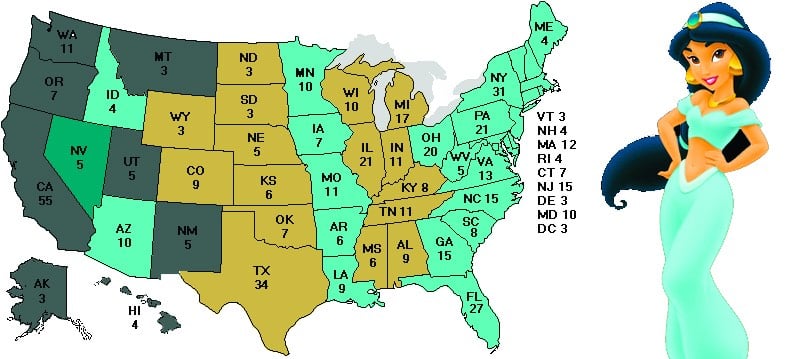
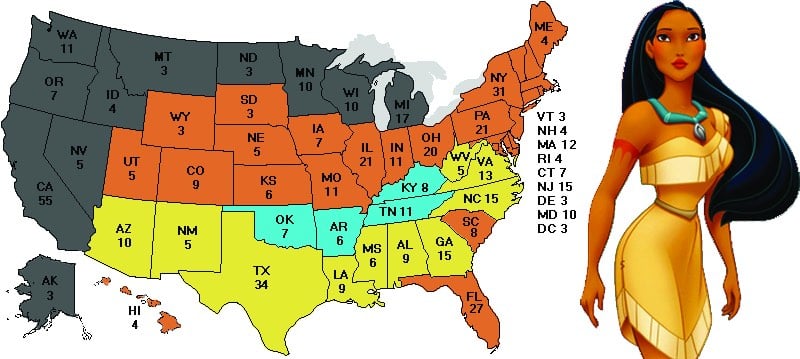
Pretty much what it says on the tin. Not much else to add.
Hey Ladies! the book
The Hey Ladies! column from The Toast is coming out in book form in May 2018 (pre-order here).
Based on the column of the same name that appeared in The Toast, Hey Ladies! is a laugh-out-loud read that follows a fictitious group of eight 20-and-30-something female friends for one year of holidays, summer house rentals, dates, brunches, breakups, and, of course, the planning of a disastrous wedding. This instantly relatable story is told entirely through emails, texts, DMs, and every other form of communication known to man.
From the column, here’s some Friendsgiving planning:
In terms of NBT aka night before thanksgiving AKA thanksgiving eve, i’m sorry to say that I won’t be here. My dad bought me a flight home (yay daddy’s girl forever haha!) and I’m leaving Monday. I saw a post on Buzzfeed about doing a friendsgiving? Is anyone interested in this? was thinking we could skip the food and just go out for tequila shots? hahah I love the holidays!
I also don’t know if anyone recalls but I will NOT be going out the night before tgiving in my hometown and that is mostly because I do not want to run the risk of seeing Jacob, my high school ex. I keyed his car in 2001 and I’m almost positive he knows it was me. What’s the statute of limitations on a crime like that? I’ve been listening to too much Serial.
Oddly, both the Times and the New Yorker have run knockoff “Hey Ladies!” pieces in the past couple of months. Not so cool.
Last Flag Flying
Directed by Richard Linklater, Last Flag Flying tells the story of three army buddies (played by Bryan Cranston, Steve Carell, and Laurence Fishburne) who reunite when one of their sons is killed in combat. Judging from the trailer, this looks great, but what’s interesting is that this is a sequel of sorts to a Hal Ashby movie from more than 40 years ago.
Last Flag Flying is a sequel to Hal Ashby’s The Last Detail, which arrived all the way back in 1973. Both movies are based on novels of the same name from Darryl Poniscan (he published Last Detail in 1970 and Last Flag in 2005), and both feature the same trio of characters. Last Flag Flying finds Steve Carell playing the role Randy Quaid filled in Ashby’s original, Cranston filling in for [Jack] Nicholson, and Fishburne stepping in for Otis Young.
Black holes could delete the Universe
In their latest video, Kurzgesagt takes a look at black holes, specifically how they deal with information. According to the currently accepted theories, one of the fundamental laws of the Universe is that information can never be lost, but black holes destroy information. This is the information paradox…so one or both of our theories must be wrong.
The paradox arose after Hawking showed, in 1974-1975, that black holes surrounded by quantum fields actually will radiate particles (“Hawking radiation”) and shrink in size (Figure 4), eventually evaporating completely. Compare with Figure 2, where the information about the two shells gets stuck inside the black hole. In Figure 4, the black hole is gone. Where did the information go? If it disappeared along with the black hole, that violates quantum theory.
Maybe the information came back out with the Hawking radiation? The problem is that the information in the black hole can’t get out. So the only way it can be in the Hawking radiation (naively) is if what is inside is copied. Having two copies of the information, one inside, one outside, also violates quantum theory.
So maybe black holes holographically encode their information on the surface?
A Blue Angels jet surprises a crowd with a low pass
Sunday at The Chicago Air and Water Show, a Blue Angels combat jet flew very low past an unsuspecting crowd and surprised the bejeezus out of some folks. It’s worth watching this video on a large screen multiple times while focusing on the reaction of a different person each time. You can see how low and fast the plane was flying from another angle. They also flew between the buildings downtown.
How fast could LeBron James run a mile? 4:40? 4:20?
A Most American Terrorist: The Making of Dylann Roof
Before yesterday, I never wanted to hear or read about Dylann Roof ever again. But Rachel Kaadzi Ghansah’s superb piece in GQ about what led Roof to commit his terroristic act is very much worth reading.
Felicia Sanders, one of the few survivors, told the courtroom early on that Roof belonged in the pit of hell. Months later, she said that because of him she can no longer close her eyes to pray. She can’t stand to hear the sound of firecrackers, or even the patter of acorns falling. Because of Dylann Roof, Felicia Sanders had been forced to play dead by lying in her dying son’s blood, while holding her hand over her whimpering grandbaby’s mouth. She had pressed her hand down so tight that she said she feared she would suffocate the girl. Eighteen months later, Felicia Sanders pointed that same hand toward Dylann Roof in the courtroom and said, with no doubt in her voice at all, that it was simple — that man there was “pure evil.”
Their vitriol was warranted but also unexpected, since in most of the press coverage of the shooting it had largely been erased. Almost every white person I spoke with in Charleston during the trial praised the church’s resounding forgiveness of the young white man who shot their members down. The forgiveness was an absolution of everything. No one made mention that this forgiveness was individual, not collective. Some of the victims and their families forgave him, and some of them did not. No one acknowledged that Dylann Roof had not once apologized, shown any remorse, or asked for this forgiveness. Or the fact that with 573 days to think about his crime, Dylann Roof stood in front of the jurors and, with that thick, slow tongue of his, said without any hesitation whatsoever, “I felt like I had to do it, and I still feel like I had to do it.”
On the first morning that Felicia Sanders testified, I was seated directly behind Dylann Roof’s mother, and because she is skin and bones, it was apparent that she was having some kind of fit. She trembled and shook until her knees buckled and she slid slowly onto the bench, mouth agape, barely moving. She said, over and over again, “I’m sorry. I’m so sorry.” She seemed to be speaking to her boyfriend, but maybe it was meant for Felicia Sanders, who was soon to take the stand. A communiqué that was a part of the bond that mothers have, one that was brought up by the radiant shame one must feel when your son has wreaked unforgivable havoc on another mother’s child. Whatever it was, it was Gothic.
When behavioral economics meets a $700M Powerball jackpot
Business Insider went out onto the streets of NYC and tried to buy people’s just-purchased Powerball tickets ahead of the $700 million drawing. They did not get many takers, even when offering twice the price they paid (which meant they could just go and buy double the number of tickets and slash their odds of winning). The video says this is an example of regret avoidance.
A theory of investor behavior that attempts to explain why investors refuse to admit to themselves that they’ve made a poor investment decision so they don’t have to face the unpleasant feelings associated with that decision. Regret avoidance causes investors to not correct bad decisions, which can make those decisions worse. Regret avoidance is the result of cognitive dissonance.
As Alex Tabarrok notes, it’s also a demonstration of the endowment effect (Tabarrok: “these people are crazy!”).
In psychology and behavioral economics, the endowment effect…is the hypothesis that people ascribe more value to things merely because they own them. This is typically illustrated in two ways. In a valuation paradigm, people will tend to pay more to retain something they own than to obtain something they do not own — even when there is no cause for attachment, or even if the item was only obtained minutes ago. In an exchange paradigm, people given a good are reluctant to trade it for another good of similar value. For example, participants first given a Swiss chocolate bar were generally unwilling to trade it for a coffee mug, whereas participants first given the coffee mug were generally unwilling to trade it for the chocolate bar.
One way to think about it is if you buy a lottery ticket for $5 and someone offers you $10 and you don’t take it, financially it’s like you’ve paid $10 for the ticket, an easily replaceable item with an average worth of about $2.50 (and more likely worth nothing). But no one should be buying tickets anyway because the lottery sucks.
Great 1970 eclipse stamp by the legendary Lance Wyman

A Mexican postage stamp designed in honor of the 1970 total solar eclipse. It was designed by Lance Wyman, who also did the logo and graphics for the 1968 Olympics in Mexico City.
Knausgaard’s four-book series on the seasons
Karl Ove Knausgaard is writing a series of four books, one for each one of the seasons. The first one, Autumn, just came out yesterday.
Autumn begins with a letter Karl Ove Knausgaard writes to his unborn daughter, showing her what to expect of the world. He writes one short piece per day, describing the material and natural world with the precision and mesmerising intensity that have become his trademark. He describes with acute sensitivity daily life with his wife and children in rural Sweden, drawing upon memories of his own childhood to give an inimitably tender perspective on the precious and unique bond between parent and child. The sun, wasps, jellyfish, eyes, lice—the stuff of everyday life is the fodder for his art. Nothing is too small or too vast to escape his attention. This beautifully illustrated book is a personal encyclopaedia on everything from chewing gum to the stars. Through close observation of the objects and phenomena around him, Knausgaard shows us how vast, unknowable and wondrous the world is.
Ah, so that’s what the chewing gum thing was about. The NY Times review is positive overall with a few caveats. The Times also did a By the Book with Knausgaard in which he shares “books I want to read, books I have to read and books I believe I need to read […] we are talking about id, ego and superego books”. Among his book picks are Pond by Claire-Louise Bennett and The Brain: The Story of You by David Eagleman. There is also this:
I hardly ever laugh.
LOL Knausgaard.
The oldest known photo of a US President
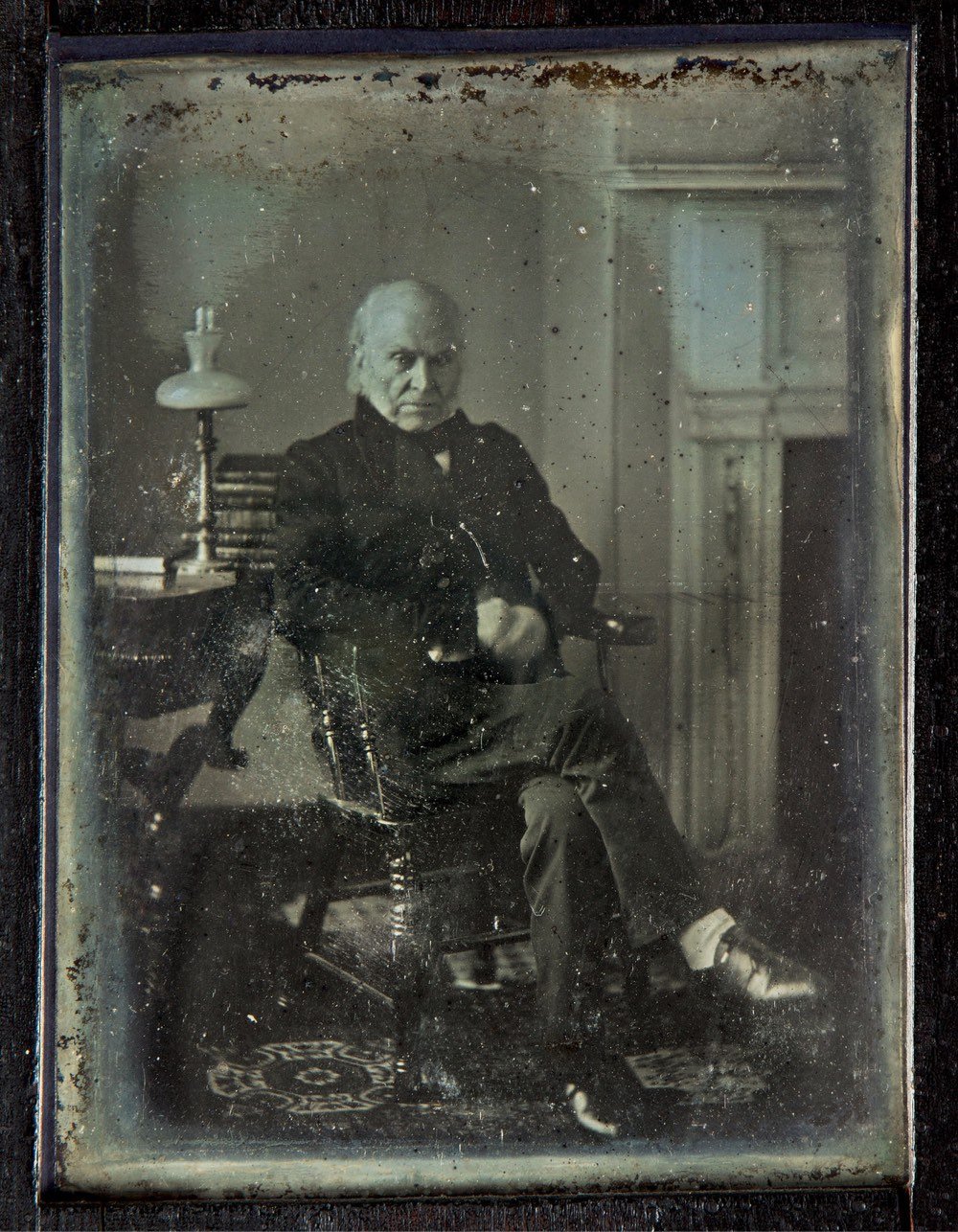
A daguerreotype photograph taken of President John Quincy Adams in 1843 has recently surfaced and is due to be auctioned off by Sotheby’s in October.
The daguerreotype, which carries an estimate of $150,000 to $250,000, was taken in a Washington portrait studio in March 1843, when Adams was in the middle of his post-presidential career in Congress. He gave it as a gift to a fellow representative, whose descendants kept it in the family while apparently losing track of its significance.
Emily Bierman, the head of Sotheby’s photographs department, called it “without a doubt the most important historical photo portrait to be offered at auction in the last 20 years.”
It’s mind-blowing that there are photos of the 6th President of the US — James Monroe, the 5th President, was not photographed. Adams was born in 1767, several years before the Revolution, and served as President until 1829, but he isn’t the earliest born person to be photographed. That honor (probably) belongs to John Adams (no relation), who was born in 1745.
I love these Tesla drag race videos. At 3:22, watch the Tesla SUV hold its own vs a Lamborghini Aventador
The best photos and videos of the 2017 solar eclipse
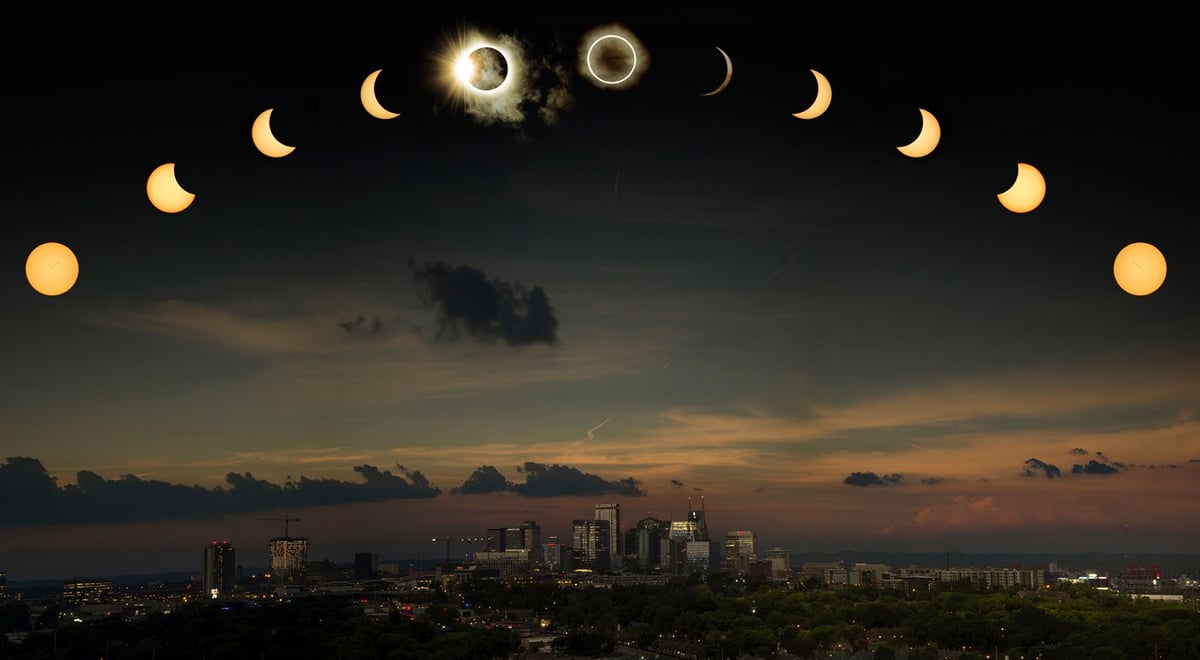
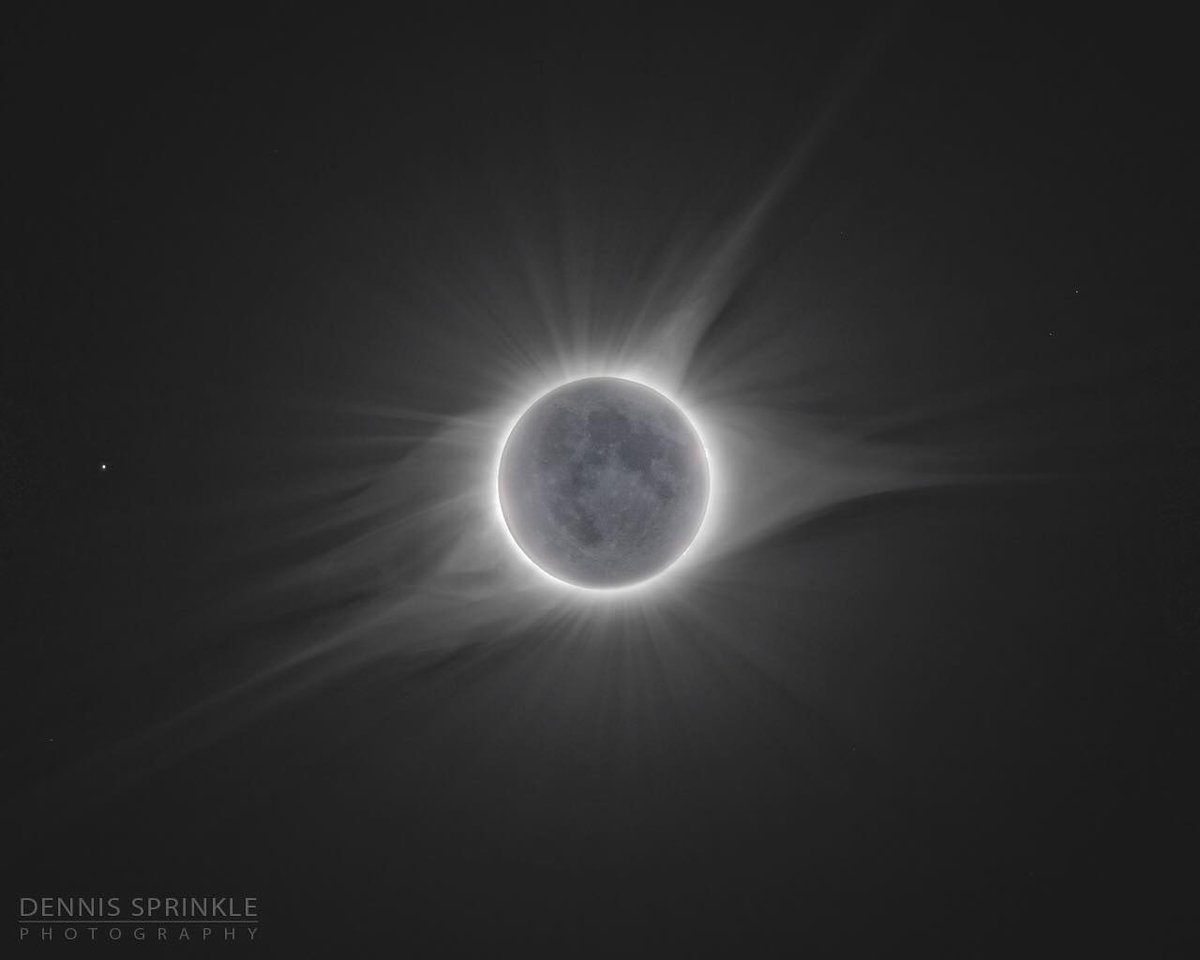
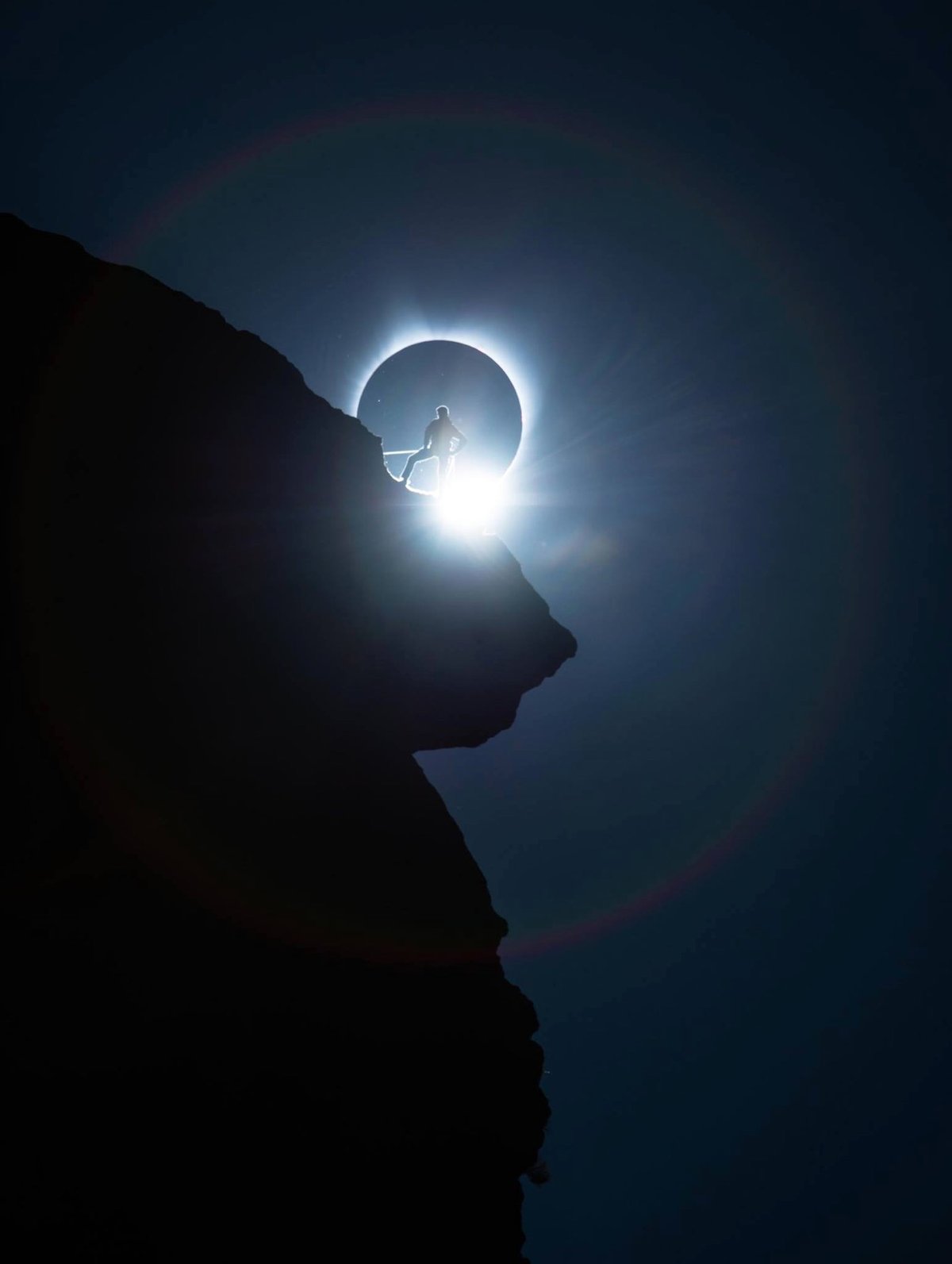
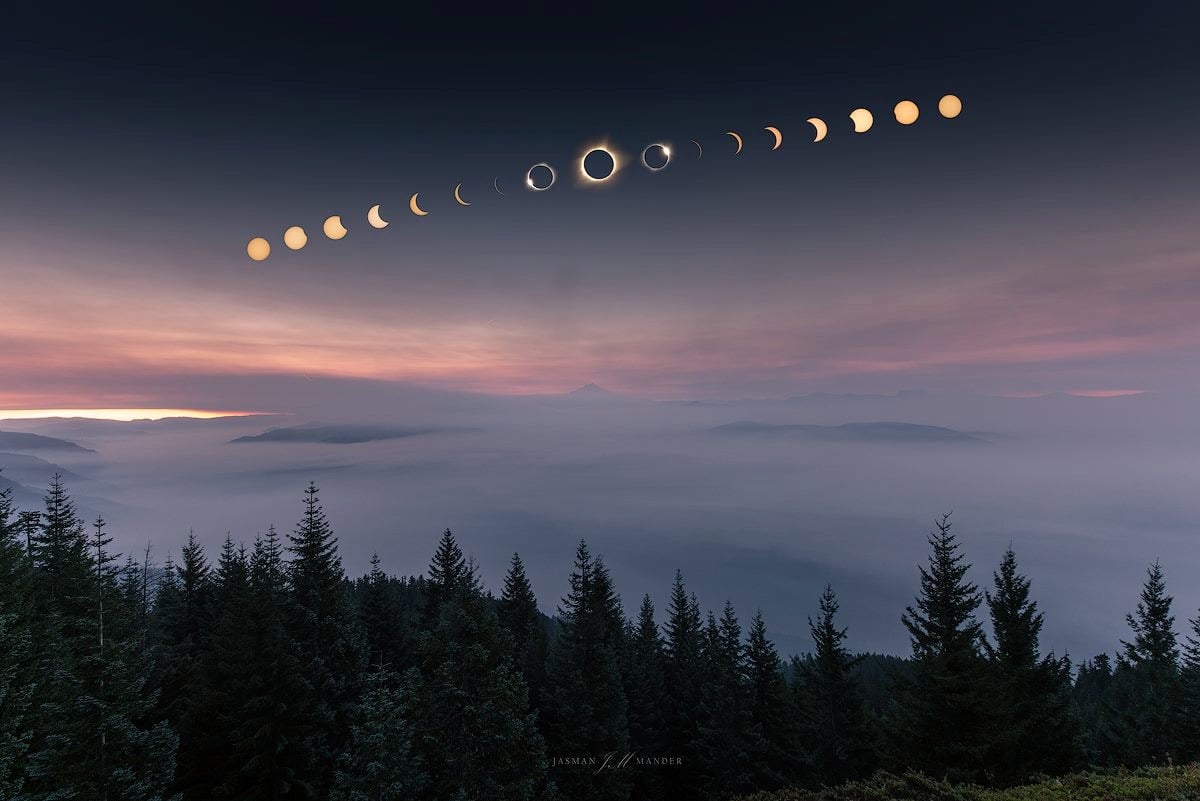

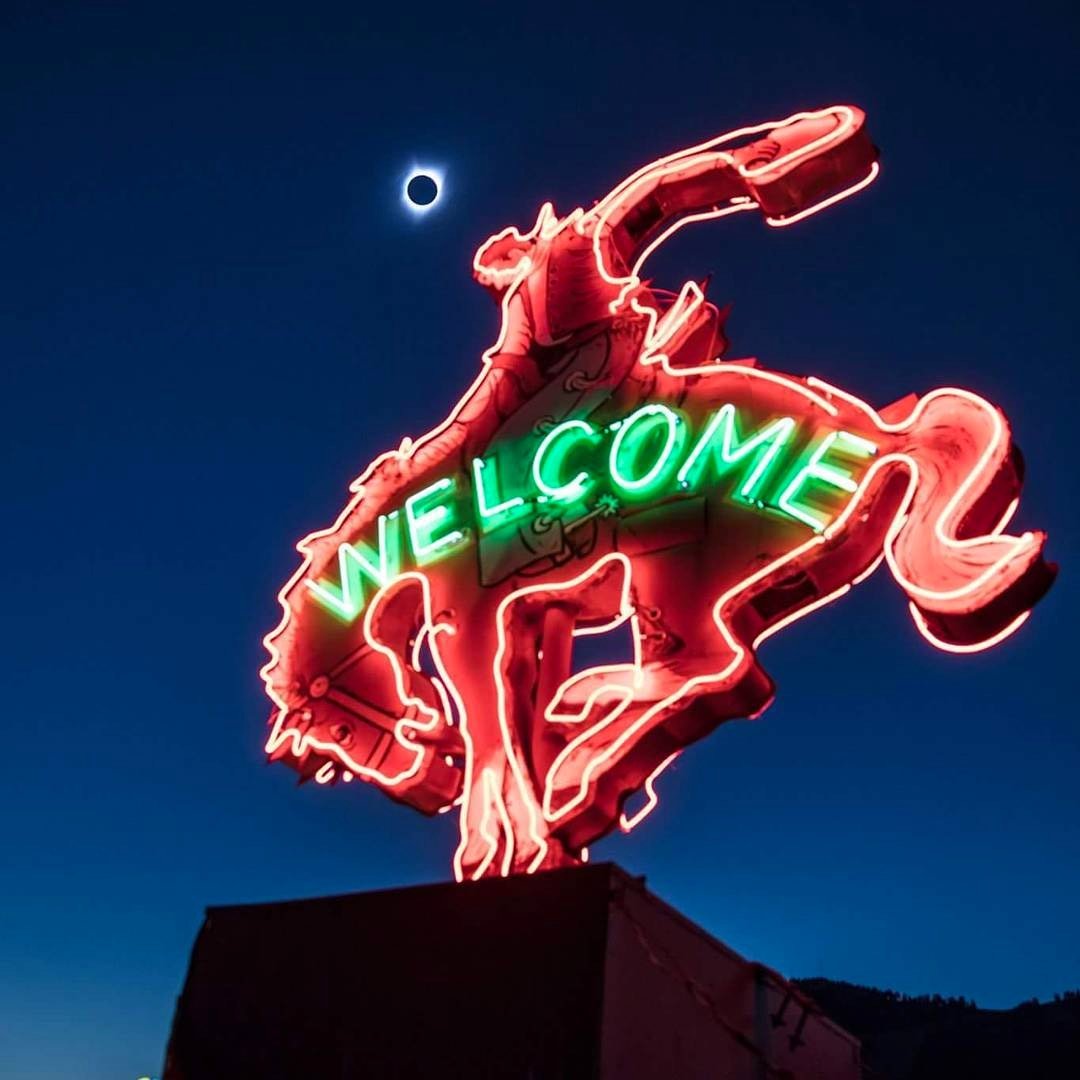

Photo and video credits from the top: Nashville progression photo by Richard Sparkman. HDR photo with Moon detail by Dennis Sprinkle (this one blew my mind a little). Rock climber by Ted Hesser (the story behind the photo). Progression photo by Jasman Lion Mander. Photo from the Alaska Airlines flight by Tanya Harrison. Video of the eclipse shadow moving across the Earth from the NOAA’s DSCOVR satellite. Neon cowboy photo by Rick Armstrong. ISS transit photo and video by Joel Kowsky. Partial eclipse video by NASA’s SDO spacecraft. Partial eclipse video by the ESA’s Proba-2 satellite. Video of the eclipse shadow moving across the US by the NOAA’s GOES-16 weather satellite. Time lapse video from The Salt Lake Tribune. Amazing 4K close-up video by JunHo Oh, ByoungJun Jeong, and YoungSam Choi…check out those prominences!
More eclipse photos on Petapixel (and here), BBC, Bored Panda, The Verge, and the NY Times.
Update: I added the time lapse video from The Salt Lake Tribune. (via the kid should see this)
Update: Added the 4K close-up video.
Alaska’s permafrost is melting. Lots of carbon in there…
What witnessing a total eclipse is like
In an essay from 1982 about her seeing a total solar eclipse in Washington (recently republished in this collection), Pulitzer Prize winner Annie Dillard puts into words what I only attempted to express in my eclipse experience.
I had seen a partial eclipse in 1970. A partial eclipse is very interesting. It bears almost no relation to a total eclipse. Seeing a partial eclipse bears the same relation to seeing a total eclipse as kissing a man does to marrying him, or as flying in an airplane does to falling out of an airplane. Although the one experience precedes the other, it in no way prepares you for it.
I heard lots of disappointment with the eclipse among friends and on social media. It was neat — look, there’s a chunk out of the Sun — but they thought it would be darker or that the air would get colder. But none of that stuff really happens unless you’re really close to totality…and then it goes completely dark and your brain turns inside out. Twitter user @hwoodscotty said:
Probably the coolest thing I’ve ever seen. Totality is so much different than even 99%. 10/10 Would recommend.
Standing on a mountaintop for totality was crossing into another dimension, suddenly finding ourselves on another world. Amazing. Sparkling ring, sun fire ghostly streaming, darkest circle. I understand now why people chase the eclipse. Totality is unlike anything. Entire landscape shifted, valleys, hills, mountains painted in nightcolour and cold. Sparkling planets came out in a midnight sky.
But back to Dillard’s piece…this part, about the shadow rushing towards them, sounds amazing:
I have said that I heard screams. (I have since read that screaming, with hysteria, is a common reaction even to expected total eclipses.) People on all the hillsides, including, I think, myself, screamed when the black body of the moon detached from the sky and rolled over the sun. But something else was happening at that same instant, and it was this, I believe, which made us scream.
The second before the sun went out we saw a wall of dark shadow come speeding at us. We no sooner saw it than it was upon us, like thunder. It roared up the valley. It slammed our hill and knocked us out. It was the monstrous swift shadow cone of the moon. I have since read that this wave of shadow moves 1,800 miles an hour. Language can give no sense of this sort of speed — 1,800 miles an hour. It was 195 miles wide. No end was in sight — you saw only the edge. It rolled at you across the land at 1,800 miles an hour, hauling darkness like plague behind it. Seeing it, and knowing it was coming straight for you, was like feeling a slug of anesthetic shoot up your arm. If you think very fast, you may have time to think, “Soon it will hit my brain.” You can feel the deadness race up your arm; you can feel the appalling, inhuman speed of your own blood. We saw the wall of shadow coming, and screamed before it hit.
Next time, and there will definitely be a next time, I’m hoping to get up high somewhere so I can see the shadow and more of the 360-degree sunset. BRB, pricing plane tickets to Argentina…
Update: Before the 2017 eclipse, Vox talked to some eclipse chasers about what it’s like to witness a total solar eclipse.
Joss Fong, who produced the video, shared the following on Twitter:
now that i’ve recovered from the drive, i can say that a lot of what these eclipse chasers told me makes sense now. agree completely that it’s something you have to see for yourself. what was different for me though is …. i got pretty sad. there’s a fine line between awe and grief. maybe in a different year it would have gone the other way, but tbh every exceptionally beautiful sunset makes me a tiny bit sad too. but this was sunset sadness times a thousand. absolutely punched by the impermanence. i hope i see it again and i hope you can see it too.
Update: From XKCD:
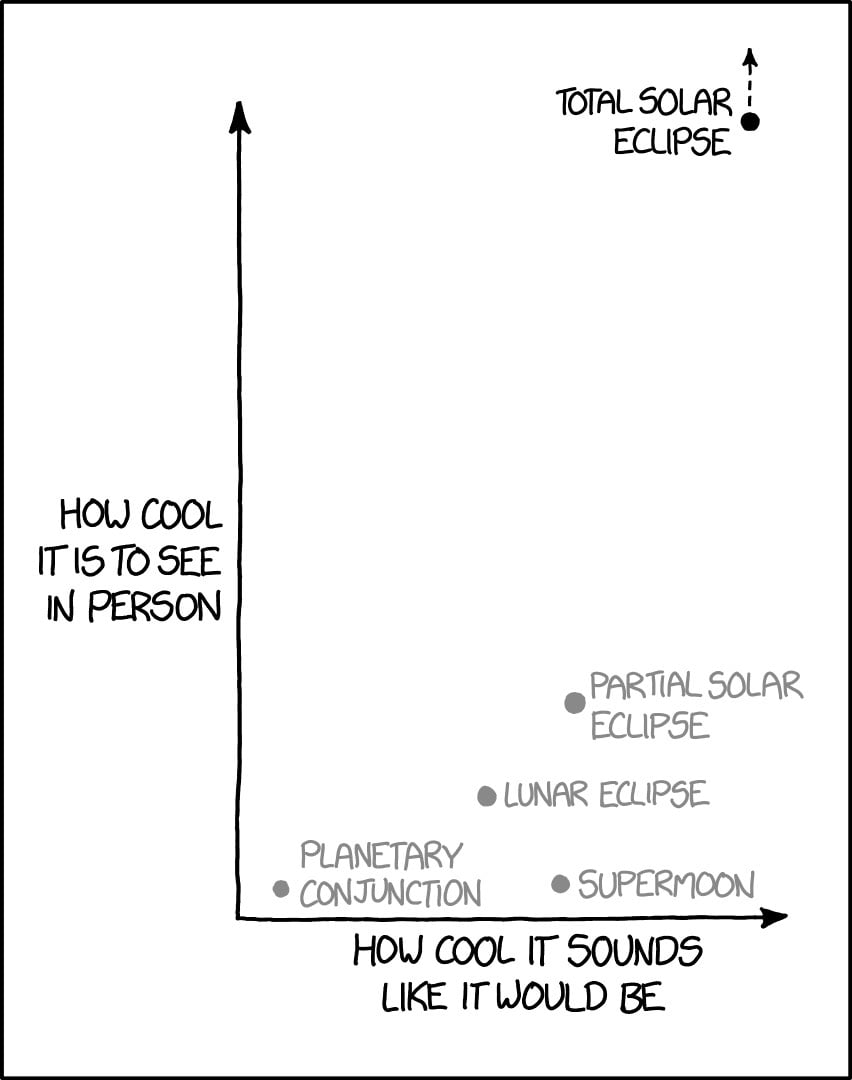
I watched from a beautiful nature reserve in central Missouri, and it was — without exaggeration — the coolest thing I’ve ever seen.
3-Way (Not Calling)
This is NSFW and pretty funny. 3-Way (Not Calling) is a short film about one couple’s attempt to spice things up in the bedroom with another person and how it goes slightly wrong and also slightly right. (via film school rejects)
My 2017 Total Solar Eclipse Trip
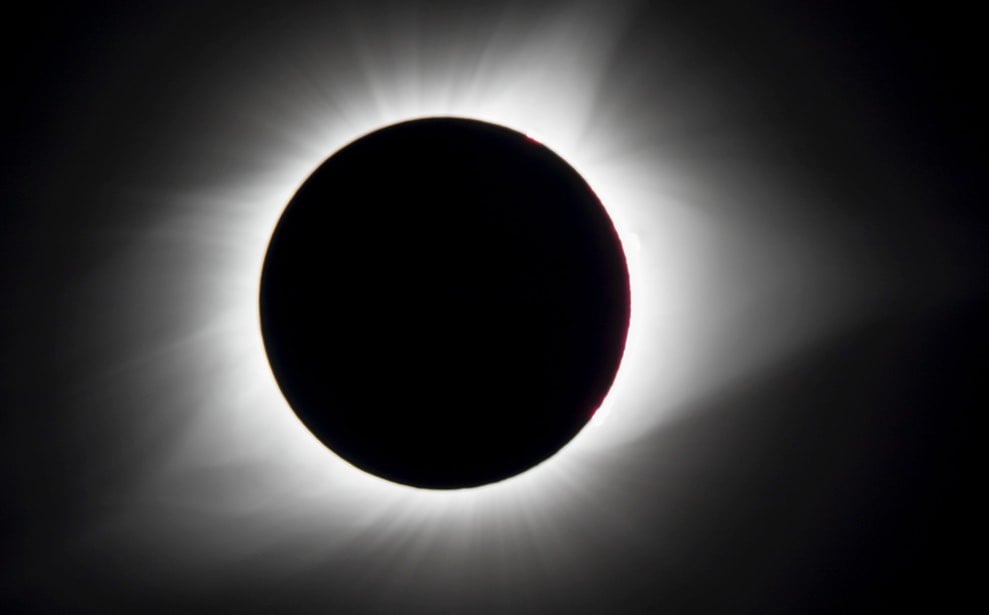
I was not prepared for how incredible the total eclipse was. It was, literally, awesome. Almost a spiritual experience. I also did not anticipate the crazy-ass, reverse storm-chasing car ride we’d need to undertake in order to see it.
I’m not a bucket list sort of person, but ever since seeing a partial eclipse back in college in the 90s (probably this one), I have wanted to witness a total solar eclipse with my own eyes. I started planning for the 2017 event three years ago…the original idea was to go to Oregon, but then some college friends suggested meeting up in Nebraska, which seemed ideal: perhaps less traffic than Oregon, better weather, and more ways to drive in case of poor weather.
Well, two of those things were true. Waking up on Monday, the cloud cover report for Lincoln didn’t look so promising. Rejecting the promise of slightly better skies to the west along I-80, we opted instead to head southeast towards St. Joseph, Missouri where the cloud cover report looked much better. Along the way, thunderstorms started popping up right where we were headed. Committed to our route and trusting this rando internet weather report with religious conviction, we pressed on. We drove through three rainstorms, our car hydroplaning because it was raining so hard, flood warnings popping up on our phones for tiny towns we were about to drive through. Morale was low and the car was pretty quiet for awhile; I Stoically resigned myself to missing the eclipse.
But on the radar, hope. The storms were headed off to the northeast and it appeared as though we might make it past them in time. The Sun appeared briefly through the clouds and from the passenger seat, I stabbed at it shining through the windshield, “There it is! There’s the Sun!” We angled back to the west slightly and, after 3.5 hours in the car, we pulled off the road near the aptly named town of Rayville with 40 minutes until totality, mostly clear skies above us. After our effort, all that was missing was a majestic choral “ahhhhhh” sound as the storm clouds parted to reveal the Sun.
My friend Mouser got his camera set up — he’d brought along the 500mm telephoto lens he uses for birding — and we spent some time looking at the partial eclipse through our glasses, binoculars (outfitted with my homemade solar filter), and phone cameras. I hadn’t seen a partial eclipse since that one back in the 90s, and it was cool seeing the Sun appear as a crescent in the sky. I took this photo through the clouds:

Some more substantial clouds were approaching but not quickly enough to ruin the eclipse. I pumped my fist, incredulous and thrilled that our effort was going to pay off. As totality approached, the sky got darker, our shadows sharpened, insects started making noise, and disoriented birds quieted. The air cooled and it even started to get a little foggy because of the rapid temperature change.
We saw the Baily’s beads and the diamond ring effect. And then…sorry, words are insufficient here. When the Moon finally slipped completely in front of the Sun and the sky went dark, I don’t even know how to describe it. The world stopped and time with it. During totality, Mouser took the photo at the top of the page. I’d seen photos like that before but had assumed that the beautifully wispy corona had been enhanced with filters in Photoshop. But no…that is actually what it looks like in the sky when viewing it with the naked eye (albeit smaller). Hands down, it was the most incredible natural event I’ve ever seen.
After two minutes — or was it several hours? — it was over and we struggled to talk to each other about what we had just seen. We stumbled around, dazed. I felt high, euphoric. Raza Syed put it perfectly:
It was beautiful and dramatic and overwhelming — the most thrillingly disorienting passage of time I’ve experienced since that one time I skydived. It was a complete circadian mindfuck.
After waiting for more than 20 years, I’m so glad I finally got to witness a total solar eclipse in person. What a thing. What a wondrous thing.
Update: Here are some reports from my eclipse-chasing buddies: a photo of Mouser setting up his camera rig, Nina’s sharp shadow at 99% totality, and Mouser’s slightly out-of-focus shot of the Sun at totality (with an account of our travels that day).
The untold story of the Mississippi Delta Chinese
As part of a video series on Chinese food in America, Al Jazeera profiles the small population of Chinese-American families that have lived in the Mississippi Delta for more than 100 years.
There’s a rather unknown community of Chinese-Americans who’ve lived in the Mississippi Delta for more than a hundred years. They played an important role in the segregated South in the middle of the 20th century. Join us as we get a taste of Southern Chinese food and learn about the unique history of the Delta Chinese.
Originally coming to the area to pick cotton, many of the Chinese immigrants opened up grocery stores, mostly in the black communities in which they lived. One family owned two stores across the street from each other in the days of segregation: one for serving white customers and the other for serving black customers.
And, oh man, that Southern Chinese food looks absolutely delicious. This NPR story, The Legacy Of The Mississippi Delta Chinese, contains a little more information on the food.
But let’s get back to dinner. As the group gets busy chopping and sauteing in the kitchen, Gilroy heads outside and starts tossing fried rice in a gigantic wok nestled into a super-hot, custom burner stand.
He tosses in some cubed ham: “This is what makes it Southern fried rice!” he says.
Before long, an impressive feast is laid out before us: beef with cauliflower. Whole fish garnished with fried ginger. Spare ribs with carrots and potatoes. Roast pork with a honey-hoisin glaze, and much more. The flavors of their youth.
Walter Cronkite reports on the 1979 solar eclipse
The last total solar eclipse in the US and Canada took place in February 1979. Here’s Walter Cronkite’s original report on the eclipse for the CBS Evening News. It features druids, a rooster that was supposed to sleep during the eclipse, and interviews with some people who were obviously tripping balls during the celestial event.
See also this 1979 ABC News anchor saying “may the shadow of the moon fall on a world at peace” about the 2017 eclipse. (via @EricHolthaus)
Solar eclipse myth busted: it’s perfectly safe for kids to be outside during an eclipse
Throughout history, total solar eclipses have been unnerving. To ancient cultures, they signified bad omens, the apocalypse, or that the Sun was being eaten by a sky creature.
There were a tumult, and disorder. All were disquieted, unnerved, frightened. Then there was weeping. The commonfolk raised a cup, lifting their voices, making a great din, calling out shrieking. People of light complexion were slain as sacrifices; captives were killed. All offered their blood.
But even in modern times, a lack of scientific understanding of what happens during a solar eclipse can cause apprehension and panic. Until hearing the same story from two different people in the past week, I had no idea that during solar eclipses, it is routine for schoolchildren to be kept inside until the “danger” has passed. Charles Fulco, a NASA and AAS 2017 U.S. Eclipse Educator, is trying to allay these fears by addressing common eclipse misconceptions.
“The Sun is more dangerous during an eclipse.” This is utter nonsense and for some reason, has persisted into the 21st Century. An eclipsed Sun is no more dangerous than the “everyday” Sun, but for some reason, some districts still keep teachers and students in their rooms with pulled shades, watching the eclipse on a screen, rather than outdoors, safely and under the care of a professional educator. I believe their fear of nature is transferred to the students as well: If the adult says an eclipse is scary and dangerous, than it must be!
As I make my final preparations for my eclipse travels (rural western Wyoming, if you’re curious) I’m hearing stories that are making me very unhappy: Some school districts across the country are telling children to stay inside during the eclipse, out of fear they’ll damage their eyes.
Let me be clear: Schools, administrators, teachers, parents: Don’t do this. YOU CAN LET THE KIDS SEE THE ECLIPSE. You just have to be safe about it.
I can appreciate the difficulty of telling 25 first graders there’s something cool happening with the Sun and then trying to get them not to look directly at it, but keeping kids inside is not the answer. For one thing, they’re missing out on a genuine celestial spectacle & learning opportunity and for another, you’re teaching people bad science. A friend, who is one of the smartest people I know, was genuinely concerned for her kids’ safety during the eclipse because when she was a kid, she was kept inside a classroom with the shades drawn because, she was told, it was dangerous for them to be outside. Dangerous to be outside in the sunshine! A clear case of educators doing the exact opposite of what they should be doing.
A simulated “play-by-play” of a total eclipse
This video from the Weather Channel is pretty neat and useful: a play-by-play of what to expect during the eclipse, from being able to see Venus in broad daylight to animals possibly acting weird to the 360-degree “sunset” that happens about 2 minutes before totality.
Viewing a total solar eclipse from an airplane
On March 8-9, 2016, a total solar eclipse swept across the Pacific Ocean for more than 5 hours. About a year before the eclipse, Hayden Planetarium astronomer Joe Rao realized Alaska Airlines flight 870 from Anchorage to Honolulu would pass right through the path of totality…but 25 minutes too early. Rao called the airline and convinced them to shift the flight time.
Alaska’s fleet director, Captain Brian Holm, reviewed the proposed flight path and possible in-route changes to optimize for the eclipse. The schedule planning team pushed back the departure time by 25 minutes, to 2 p.m.
On the day of the flight, Dispatch will develop the specific flight plan, to find the most efficient route and account for weather and wind. Maintenance and maintenance control will help make sure the plane is ready to go — they even washed all the windows on the right side of the plane.
Captain Hal Andersen also coordinated with Oceanic Air Traffic Control, to make them aware that the flight might require a few more tactical changes then normal.
“The key to success here is meeting some very tight time constraints — specific latitudes and longitudes over the ocean,” Andersen said. “With the flight management computer, it’s a pretty easy challenge, but it’s something we need to pay very close attention to. We don’t want to be too far ahead or too far behind schedule.”
The video was shot by a very excited Mike Kentrianakis of the American Astronomical Society, who has witnessed 20 solar eclipses during his lifetime.
July 11, 2010. That was the eclipse over Easter Island, the one for which hotel room rates were so high that there was no way Kentrianakis could afford it. Instead, he considered attempting a trip to Argentina, where experts predicted there was a 5 percent chance of clear skies. His wife at the time, Olga, urged him not to go — it’s not worth the expense, she insisted. Reluctantly, Kentrianakis stayed home.
“It was the beginning of the end for us,” Kentrianakis says. There were problems in the marriage before that episode, “but it affected me that I felt that she didn’t really appreciate what I loved.” They were divorced the following year.
Kentrianakis doesn’t like to dwell on this, or the other things he’s given up to chase eclipses. He knows his bosses grumbled about the missed days of work. Friends raise their eyebrows at the extremes to which he goes. He’s unwilling to admit how much he’s spent on his obsession.
“There is a trade-off for everything, for what somebody wants,” he says.
A camera on the Deep Space Climate Observatory satellite captured the eclipse’s shadow as it moved across the Earth:
For this year’s eclipse, Alaska Airlines is doing a special charter flight for astronomy nerds and eclipse chasers. Depending on how this eclipse goes, seeing an eclipse from an airplane might be on my bucket list for next time. (via @coudal)
Look at this graph of American antigovernment groups. Huh, I wonder what could have happened in 2008?
Heritage, racism, and Confederate flags in New England
Back in 2015, Emily Heath wrote for HuffPost:
I saw your truck parked in front of the Rite-Aid, right by the Dunkin Donuts. Two large Confederate flags were attached to the back of it, waving in the wind. The American flag was, incongruously, in the center. And, I have to confess, I don’t get it.
Part of me wanted to ask obvious questions: You know you are in New Hampshire, right? And, you know New Hampshire was not a part of the Confederacy?
I ask this because I’m not so sure you do. Here we are in a northern town, a place that gave her sons up to the Union Army and lost them on the battlefields of the Civil War. A place where locals organized early against slavery and led the charge against it across the country. A place where 150 years ago that flag would have been seen as a symbol of treason.
I live in Vermont. It’s a pretty liberal place; along with Hawaii, Vermont had the lowest statewide level of support for Trump in the 2016 election. But it is also a very white place…the second whitest state in the US as of the last census. Earlier this week, I drove past a house with the Confederate flag hanging on a flagpole in the front yard, right below the American flag. It’s not something you see super-often, but you do see it, along with Blue Lives Matter bumper stickers, Take Back Vermont signs painted on barns, and the perhaps well-intentioned older white couple holding up “We Believe Black Lives Matter Because All Lives Matter” signs on a small town sidewalk after the white supremacist demonstration in Charlottesville. Last year at the Champlain Valley Fair, there were multiple vendors selling Confederate flags, shirts, bandanas, and the like.
I am inclined to agree with Heath on this: the display of the Confederate flag is racist.
I think you believe that the flag brands you as a “rebel” or somehow honors your outlook on life. It doesn’t. It brands you as a racist. You may not think you are one, but flying that flag is a racist act.
I know that right now you are saying, “But I’m not a racist!” “Heritage, not hate!” But this isn’t your heritage. It’s mine. And it is hate. And it is racism. And every time you put that flag on the back of your car, we all go back in time a little. And the past wasn’t so great for many of our neighbors.
(via @chrispiascik)
This Book Is a Planetarium


A couple of years ago, I told you about designer Kelli Anderson’s upcoming book, This Book is a Planetarium. It took awhile to get everything just right, but I’m happy to report the book will finally be out in early October.
Defying every expectation of what a book can be, this pop-up extravaganza transforms into six fully functional tools: a real working planetarium projecting the constellations, a musical instrument complete with strings for strumming, a geometric drawing generator, an infinite calendar, a message decoder, and even a speaker that amplifies sound. Artist Kelli Anderson contributes enlightening text alongside each pop-up, explaining the scientific principles at play in her constructions and creating an interactive experience that’s as educational as it is extraordinary.
Here’s a video of Anderson playing with two of the six contraptions. She sent me a preview of the book in the form of the planetarium pop-up page (accompanied by one of these cool cards) and when I cracked it open, I actually squealed. Seriously, this thing is super awesome. We took it and my iPhone flashlight into the darkest room in the house and sure enough, there was the Big Dipper projected onto the ceiling…my kids could barely stop saying “this is so cool”. Really looking forward to seeing the real thing in October.
How to predict total solar eclipses
The Exploratorium in San Francisco has produced a great explainer video about the science of predicting total solar eclipses. Each eclipse belongs to a repeating series of eclipses called a Saros cycle that repeats every 18 years 11 days and 8 hours.
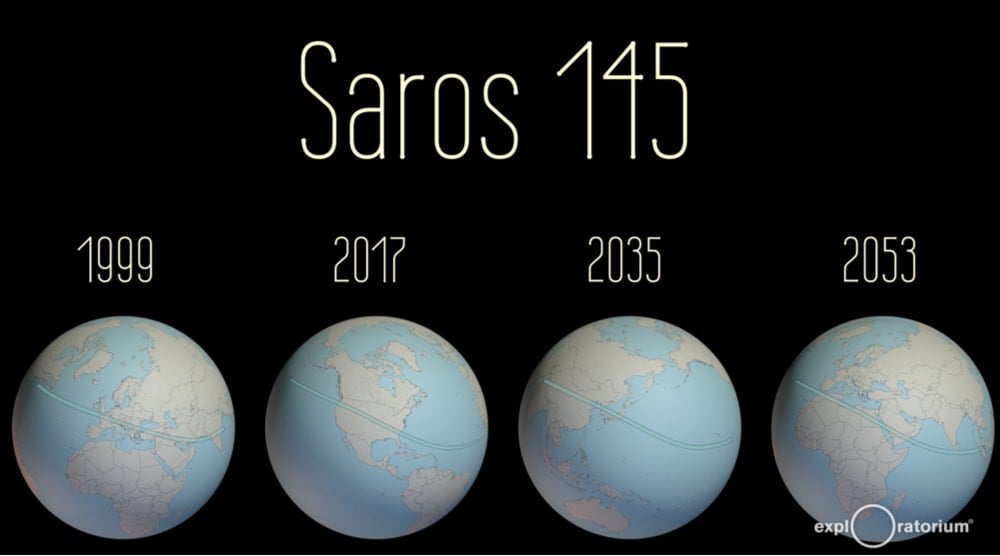
There are now 40 active Saros cycles and the August 2017 eclipse belongs to Saros 145, which produced its first total eclipse in June 1909 and will produce its last total eclipse in September 2648.
In Backing Alt-Right, A.C.L.U. Embraces Role in Defending ‘Groups We Detest’
Infographic of the fascinating timeline of the far future
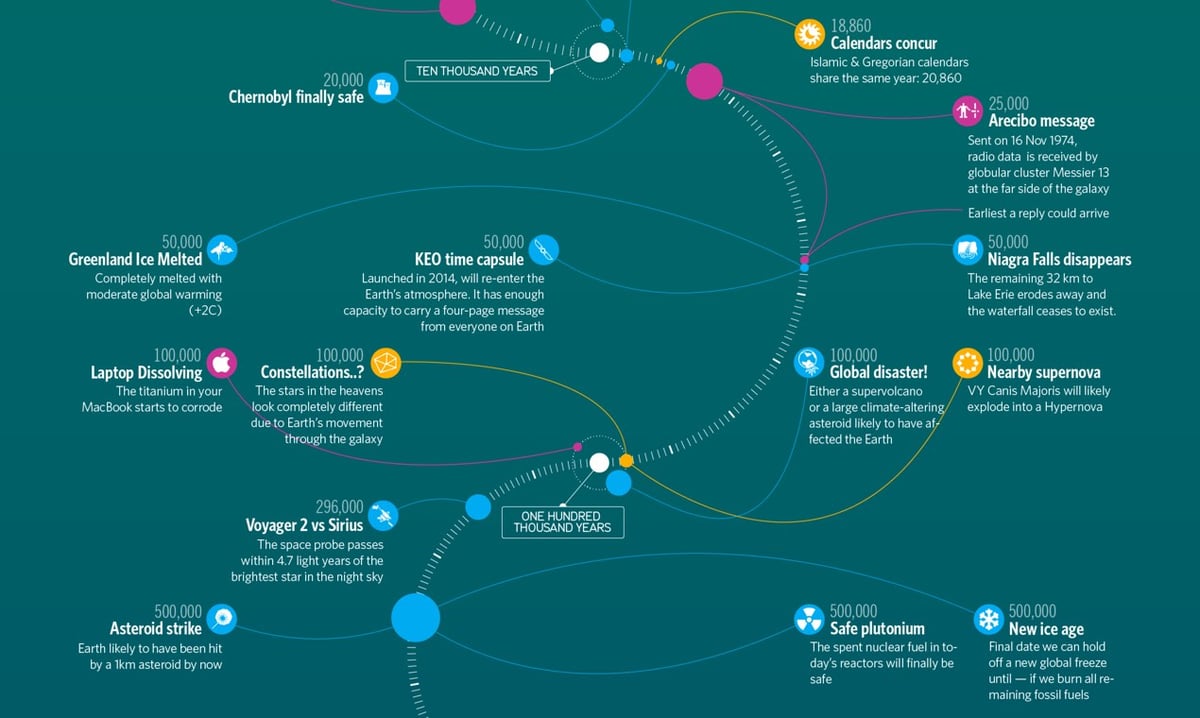
Timeline of the far future is one of my favorite pages on Wikipedia. It details what might happen to humanity, human artifacts, the Earth, the solar system, and the Universe from 10,000 years from now until long past the heat death of the Universe. Information is Beautiful has made a lovely infographic of the timeline.
Reading through the timeline is a glorious way to spend time…here are a few favorites I noticed this time around as well as some from my first post.
August 20, 10,663: “A simultaneous total solar eclipse and transit of Mercury.”
20,000 years: “The Chernobyl Exclusion Zone, the 1,000 sq mi area of Ukraine and Belarus left deserted by the 1986 Chernobyl disaster, becomes safe for human life.”
296,000 years: “Voyager 2 passes within 4.3 light-years of Sirius, the brightest star in the night sky.”
1 million years: “Highest estimated time until the red supergiant star Betelgeuse explodes in a supernova. The explosion is expected to be easily visible in daylight.”
1 million years: “On the Moon, Neil Armstrong’s ‘one small step’ footprint at Tranquility Base will erode by this time, along with those left by all twelve Apollo moonwalkers, due to the accumulated effects of space weathering.”
15.7 million: “Half-life of iodine-129, the most durable long-lived fission product in uranium-derived nuclear waste.”
100 million years: “Future archaeologists should be able to identify an ‘Urban Stratum’ of fossilized great coastal cities, mostly through the remains of underground infrastructure such as building foundations and utility tunnels.”
1 billion years: “Estimated lifespan of the two Voyager Golden Records, before the information stored on them is rendered unrecoverable.”
4 billion years: “Median point by which the Andromeda Galaxy will have collided with the Milky Way, which will thereafter merge to form a galaxy dubbed ‘Milkomeda’.”
7.59 billion years: The Earth and Moon are very likely destroyed by falling into the Sun, just before the Sun reaches the tip of its red giant phase and its maximum radius of 256 times the present-day value. Before the final collision, the Moon possibly spirals below Earth’s Roche limit, breaking into a ring of debris, most of which falls to the Earth’s surface.
100 billion years: “The Universe’s expansion causes all galaxies beyond the Milky Way’s Local Group to disappear beyond the cosmic light horizon, removing them from the observable universe.”
The Paradox of Tolerance

In his 1945 book The Open Society and Its Enemies, political philosopher Karl Popper asserted that tolerance need not be extended to those who are intolerant.
Less well known is the paradox of tolerance: Unlimited tolerance must lead to the disappearance of tolerance. If we extend unlimited tolerance even to those who are intolerant, if we are not prepared to defend a tolerant society against the onslaught of the intolerant, then the tolerant will be destroyed, and tolerance with them. In this formulation, I do not imply, for instance, that we should always suppress the utterance of intolerant philosophies; as long as we can counter them by rational argument and keep them in check by public opinion, suppression would certainly be unwise. But we should claim the right to suppress them if necessary even by force; for it may easily turn out that they are not prepared to meet us on the level of rational argument, but begin by denouncing all argument; they may forbid their followers to listen to rational argument, because it is deceptive, and teach them to answer arguments by the use of their fists or pistols. We should therefore claim, in the name of tolerance, the right not to tolerate the intolerant. We should claim that any movement preaching intolerance places itself outside the law, and we should consider incitement to intolerance and persecution as criminal, in the same way as we should consider incitement to murder, or to kidnapping, or to the revival of the slave trade, as criminal.
The last part bears repeating:
We should therefore claim, in the name of tolerance, the right not to tolerate the intolerant. We should claim that any movement preaching intolerance places itself outside the law, and we should consider incitement to intolerance and persecution as criminal, in the same way as we should consider incitement to murder, or to kidnapping, or to the revival of the slave trade, as criminal.
The photo above was taken by Steve Helber of Charlottesville resident Corey Long pointing an improvised flamethrower at a group of white supremacists this past weekend. Yesha Callahan of The Root interviewed Long about that moment:
“At first it was peaceful protest,” Long said softly as he spoke. “Until someone pointed a gun at my head. Then the same person pointed it at my foot and shot the ground.”
Long said the only weapon he had was a can of spray paint that a white supremacist threw at him earlier, so he took a lighter to the spray paint and turned it into a flame thrower. And a photographer snapped the photo.
But inside every photograph is an untold story. If you look closely at Long’s picture, there’s an elderly white man standing in between Long and his friend. The unknown man was part of the counterprotests, too, but was afraid, and Long and his friends were trying to protect him. Even though, Long says, those who were paid to protect the residents of Charlottesville were doing just the opposite.
Characters saying the opening quotes from The Wire
At the beginning of each episode of The Wire, a quote from one of the show’s characters is shown on the screen, a epigraph that suggests the theme of the episode. This video shows the characters from each episode saying those opening quotes — Lester: “all the pieces matter”; Omar: “all in the game”; The Greek: “business, always business”; Poot: “world going one way, people another” — for all five seasons.
Oddly Ikea (aka Ikea ASMR)
Videos designed to invoke ASMR (“autonomous sensory meridian response”) in some viewers have grown in popularity in recent years. The videos feature soothing sounds and visuals (gentle whispering, soft scratching, watching a task being diligently performed) that are meant to provoke a response of brain tingling or a state of bliss in some people. In an attempt to ride the wave, Ikea has made a 25-minute advertisement for college dorm furniture that uses common ASMR techniques. I dunno, does cerebral euphoria make people want to buy closet organizers?
Freaks and Geeks and the 70s-ness of the early 80s
James Poniewozik, chief TV critic for the NY Times, wrote about his favorite scene from Freaks and Geeks. Here’s the scene:
I loved this bit:
First, the music. “I’m One” by the Who, from the 1973 album “Quadrophenia.” It builds from mournfulness (“I’m a loser / No chance to win”) to a defiant chorus. And it’s a great example of how “Freaks and Geeks” chose its soundtracks. The episode is set in 1981, but it avoids on-the-nose ’80s-song choices. Paul Feig, the show’s creator, once told me that the thing about the early ’80s in the Midwest was that they were really still the ’70s.
I grew up in the Midwest in the early 80s and though I’ve never really thought about it before, Feig’s observation that they were still really the 70s is spot on. (via @tcarmody)
Val Kilmer: Kurt Russell pretty much directed Tombstone. “Kurt was responsible for the film’s success.”
A tour of our solar system’s eclipses
In a meditative video for the NY Times, Dennis Overbye takes us on a tour of eclipses that happen in our solar system and beyond.
On the 21st day of August, 2017, the moon will slide between the Earth and the sun, painting a swath of darkness across North America. The Great American Solar Eclipse. An exercise in cosmic geometry. A reminder that we live on one sphere among many, all moving to the laws of Kepler, Newton and Einstein.
Humans have many more vantage points from which to observe solar eclipses than when the last solar eclipse occurred in the US in 1979. I had no idea that the Mars rovers had caught partial solar eclipses on Mars…so cool. (via @jossfong)
Scientists think the first Americans arrived by boat
The prevailing theory of how the Americas were settled has been than human hunters followed big game across the ice-free land bridge between North America and Asia around 13,000 years ago. These are the Clovis people you may have learned about in school. But evidence is mounting that the first humans to settle the Americas came down the Pacific Coast somewhat earlier than that.
The Cedros Island sites add to a small but growing list that supports a once-heretical view of the peopling of the Americas. Whereas archaeologists once thought that the earliest arrivals wandered into the continent through a gap in the ice age glaciers covering Canada, most researchers today think the first inhabitants came by sea. In this view, maritime explorers voyaged by boat out of Beringia — the ancient land now partially submerged under the waters of the Bering Strait — about 16,000 years ago and quickly moved down the Pacific coast, reaching Chile by at least 14,500 years ago.
Part of the problem in confirming this hypothesis is that the rise in sea level that accompanied the melting of the glaciers (a 120-meter rise globally) submerged likely settlement sites, trapping archeological evidence under hundreds of feet of ocean. (via @CharlesCMann)
Prince gets his own Pantone color

It’s official: Prince and purple are together forever. The Pantone Color Institute has created “a standardized custom color” to honor Prince.
The (naturally) purple hue, represented by his “Love Symbol #2” was inspired by his custom-made Yamaha purple piano, which was originally scheduled to go on tour with the performer before his untimely passing at the age of 57. The color pays tribute to Prince’s indelible mark on music, art, fashion and culture.
Prince’s association with the color purple was galvanized in 1984 with the release of the film Purple Rain, along with its Academy Award-winning soundtrack featuring the eponymous song. While the spectrum of the color purple will still be used in respect to the “Purple One,” Love Symbol #2, will be the official color across the brand he left behind.
“The color purple was synonymous with who Prince was and will always be. This is an incredible way for his legacy to live on forever,” said Troy Carter, Entertainment Advisor to Prince’s Estate.
Not that many other people have their own custom Pantone color. In early 2016, The NY Post reported that Jay-Z and realty company CEO Sherry Chris had signature Pantone colors, a blue and pink respectively. (via @anildash)
How to make a blockbuster movie trailer
Sure, blockbuster movie trailers are formulaic. But…actually, no buts, they are formulaic and this cheeky short video by the Auralnauts gives away all the secrets to making a really effective engaging exciting unique aggressively bland trailer for a Hollywood blockbuster movie.
Update: It’s a bit dated, but Cracked did a Trailer For Every Oscar-Winning Movie Ever:
(via @lanewinfield)
Solar eclipse searches match the path of totality
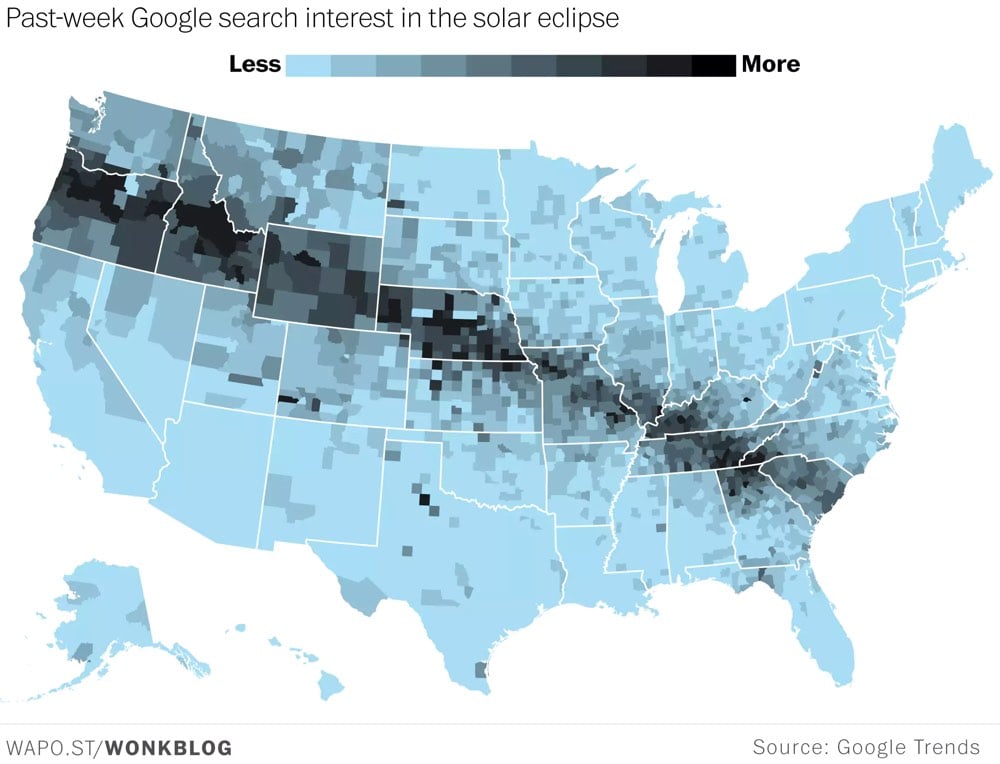
According to Google Trends, search traffic about the upcoming solar eclipse mirrors the path of totality. And according to XKCD, pre-eclipse search traffic for “eclipse” is outpacing pre-election search traffic for “election”.
From VICE News Tonight and HBO, an up-close look at the terrorism in Charlottesville
This is perhaps the best on-the-ground view of what went down in Charlottesville over the weekend. It’s graphic in spots. Prepare to get angry and sad and frustrated and scared.
On Saturday hundreds of white nationalists, alt-righters, and neo-Nazis traveled to Charlottesville, Virginia to participate in the “Unite the Right” rally. By Saturday evening three people were dead — one protester, and two police officers — and many more injured.
“VICE News Tonight” correspondent Elle Reeve went behind the scenes with white nationalist leaders, including Christopher Cantwell, Robert Ray, David Duke, and Matthew Heimbach — as well as counter-protesters. VICE News Tonight also spoke with residents of Charlottesville, members of the Black Lives Matter movement, and the Charlottesville Police.
From the neo-Nazi protests at Emancipation Park to Cantwell’s hideaway outside of Virginia, “VICE News Tonight” provides viewers with exclusive, up close and personal access inside the unrest.
More Primitive Technology: sandals, prawn traps, and water hammers
It’s been awhile since I’ve looked in on what the proprietor of the Primitive Technology YouTube channel is up to. Over the past two years, this Australian man has built all sorts of tools, structures, and objects using only what he can find in the forest and has racked up over 330 million views on his silent videos demonstrating how he does it all.
One of his latest projects was building a water-powered hammer (video above).
The trough was positioned under the waterspout to collect water and the tripod adjusted so that the resting point of the hammer was horizontal (so water wouldn’t prematurely spill out of the trough).
The trough filled with water, outweighed the hammer head and tilted the hammer up into the air. The water then emptied out of the trough (now slanting downwards) and the hammer then slammed down onto an anvil stone returning to its original position. The cycle then repeated at the approximate rate of one strike every 10 seconds. The hammer crushes small soft types of stone like sandstone or ochre. I carved a bowl into the anvil stone so that it would collect the powder. I then crushed old pottery (useful as grog for new pots) and charcoal. Practically speaking, this hammer worked ok as a proof of concept but I might adjust it or make a new one with a larger trough and bigger hammer for heavy duty work.
He also made a trap for catching freshwater prawns:
And a pair of sandals:
He’s built up quite a following on Patreon as well, with people contributing over $5700 per video, putting him on a path to be able to make Primitive Technology his full-time job.
Philip Glass: Piano Works by Víkingur Ólafsson
I’m currently listening to Philip Glass: Piano Works by Víkingur Ólafsson.
Compare with Glass’s own take on the Études. The NY Times recently interviewed Ólafsson about Glass and other things.
Mr. Olafsson’s version is often more atmospheric. Although the ‘Etude comprises a series of repeated phrases, he doesn’t settle into any patterns. He treats Mr. Glass’s music like a sculpture, worth studying from all angles in search of new interpretations and surprises.
“I came to the conclusion that it’s not a repetition,” Mr. Olafsson said of Mr. Glass’s music. “It’s a rebirth. It’s not treading the same path, but traveling in a spiral. That’s the image I have.”
The Death of Stalin
The Death of Stalin is a satirical film about the political aftermath of Joseph Stalin’s death in 1953. It stars Jeffrey Tambor, Michael Palin (as Vyacheslav Molotov, for whom the Molotov cocktail was named), and Steve Buscemi as Nikita Khrushchev (who, spoiler alert, eventually wins the succession battle for leader of the Soviet Union).
The Shyness of Trees

From Robert Macfarlane’s fascinating Twitter account comes this new-to-me term: crown shyness, a phenomenon where the leaves and branches of individual trees don’t touch those of other trees, forming gaps in the canopy.
According to Wikipedia, there are several possible causes of this phenomenon, including the inhibition of the spread of organisms harmful to trees, damage or stunted growth of new shoots caused by the trees knocking into one another in the wind, or stunting of growth because of mutual shading. Whatever the cause, I think we can all agree that the effect looks hella rad. Photo by Dag Peak from Flickr.
See also wolf trees.
Hilarious Recipe Videos in the Style of Famous Directors
David Ma is a food artist and director who recently made a series of four short recipe videos in the style of famous directors. There’s spaghetti and meatballs a la Quentin Tarantino (my favorite):
S’mores in the style of Wes Anderson:
What if Michael Bay made waffles?
And finally, here’s a pancake recipe in the style of Alfonso Cuaron’s Gravity:
Hopefully round 2 of Ma’s project will include the likes of Sofia Coppola, Ava DuVernay, Spike Lee, or Yimou Zhang.
Today’s Google logo is a set of playable turntables
In celebration of the 44th anniversary of the birth of hip hop, Google has replaced its logo with a pair of working turntables and a crate of records to scratch and mix.
On August 11, 1973, an 18-year-old, Jamaican-American DJ who went by the name of Kool Herc threw a back-to-school jam at 1520 Sedgwick Avenue in the Bronx, New York. During his set, he decided to do something different. Instead of playing the songs in full, he played only their instrumental sections, or “breaks” — sections where he noticed the crowd went wild. During these “breaks” his friend Coke La Rock hyped up the crowd with a microphone. And with that, Hip Hop was born.
The introduction and tutorial is hosted by Fab 5 Freddy, host of the groundbreaking Yo! MTV Raps show. You can play with the DJ setup here:
That was super fun…I spent more time than I would like to admit playing with that. See also Tim Carmody’s Spotify playlist, Introduction to Hip-Hop.
Trailer for season 2 of The Crown
The first season of the Netflix series The Crown was a surprise for me. I thought it was going to be pleasant-but-soapy look at the royals a la Downton Abbey (which I love, don’t get me wrong), but the acting and the substance of the script and production elevated it, putting it among the best shows to debut last year. Claire Foy as Queen Elizabeth, in particular, was a revelation; her one-on-one scenes with her sister and with Churchill were some of the best TV I watched last year. From the season 2 trailer, it appears that we’re in for more of the same come December.
A digital archive of Soviet children’s books 1917-1953

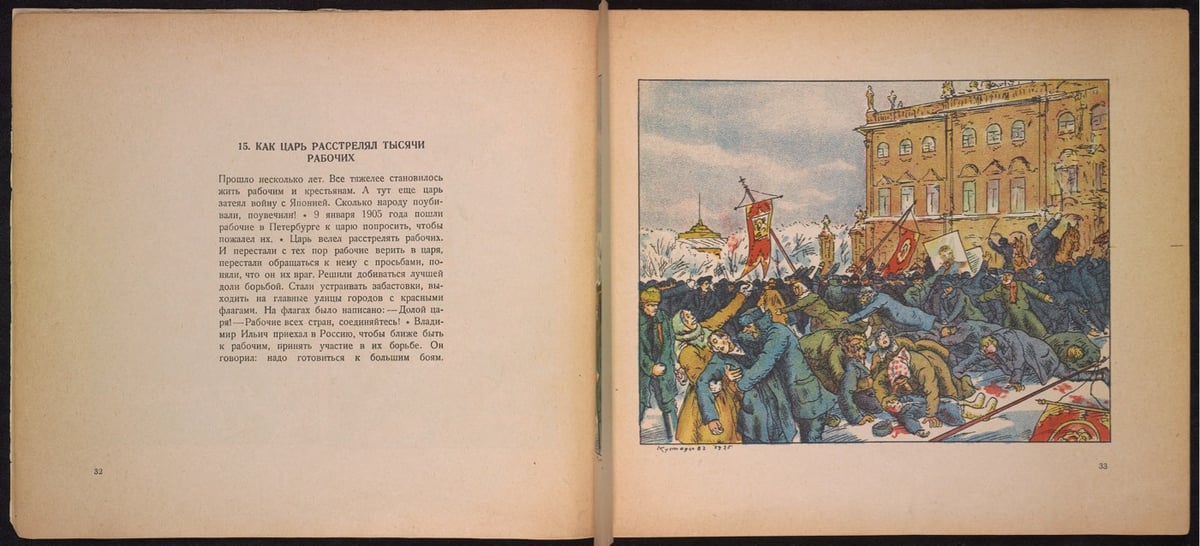
Playing Soviet is an online interactive database created by Princeton of children’s books from the Soviet Union.
In the selections featured here, the user can see first-hand the mediation of Russia’s accelerated violent political, social and cultural evolution from 1917 to 1953. These conditions saw the proliferation of new styles and techniques in all the graphic arts: the diverse productivity of the Russian avant-garde, photomontage, experimental typography, and socialist realism. As was clear both from the rhetoric of the arbiters of Soviet culture — its writers and government officials — the illustration and look of Soviet children’s books was of tantamount importance as a vehicle for practical and concrete information in the new Soviet regime. Directives for a new kind of children’s literature were founded on the assumption that the “language of images” was immediately comprehensible to the mass reader, far more so than the typed word. Illustrators were raised as equals to the revered Russian author, bringing artists such as Alexander Deineka, El Lissitzky, Vladimir Lebedev, and numerous other graphic designers to the pages of children’s books to create imaginative models for Soviet youth in the new languages of Soviet modernism.
The bottom image is from a book called For Children About Lenin, a 71-page illustrated book about Lenin and the Russian Revolution published 2 years after his death.
Recreating the Loot Train Battle from Game of Thrones
Oh, this is a clever bit of TV/film analysis by Evan Puschak: he reconstructs the Loot Train Battle from the most recent episode of Game of Thrones using clips from other movies and TV shows (like 300, Lord of the Rings, Stagecoach, and Apocalypse Now). In doing so, he reveals the structure that many filmed battle scenes follow, from the surprising enemy attack presaged by the distant sound of horses (as in 300) to the quiet mid-chaos reflection by a shocked commander (as in Saving Private Ryan). Everything is a Remix, right?
This reminds me of how the Rogue One production team made a full-length reel of the film for director Gareth Edwards from scenes from other movies so that the timing and pacing could be worked out.
It’s very simple to have a line [in the script] that reads “Krennic’s shuttle descends to the planet”, now that takes maybe 2-3 seconds in other films, but if you look at any other ‘Star Wars’ film you realise that takes 45 seconds or a minute of screen time. So by making the whole film that way — I used a lot of the ‘Star Wars’ films — but also hundreds of other films too, it gave us a good idea of the timing.
For example the sequence of them breaking into the vault I was ripping the big door closing in ‘Wargames’ to work out how long does a vault door take to close.
This fascinating behind-the-scenes look at the battle doesn’t allude to any such storyboarding, but as Puschak notes, battle scenes from dozens of other movies surely weren’t far off in their minds while putting this one together.
The size of life: the differing scales of living things
In the first in a series of videos, Kurzgesagt tackles one of my favorite scientific subjects: how the sizes of animals governs their behaviors, appearance, and abilities. For instance, because the volume (and therefore mass) of an organism increases according to the cube of the increase in length (e.g. if you double the length/height of a dog, its mass roughly increases by 8 times), when you drop differently sized animals from high up, the outcomes are vastly different (a mouse lands safely, an elephant splatters everywhere).
The bit in the video about how insects can breathe underwater because of the interplay between the surface tension of water and their water-repellant outer layers is fascinating. The effect of scale also comes into play when considering the longevity of NBA big men, how fast animals move, how much animals’ hearts beat, the question of fighting 100 duck-sized horses or 1 horse-sized duck, and shrinking people down to conserve resources.
When humans get smaller, the world and its resources get bigger. We’d live in smaller houses, drive smaller cars that use less gas, eat less food, etc. It wouldn’t even take much to realize gains from a Honey, I Shrunk Humanity scheme: because of scaling laws, a height/weight proportional human maxing out at 3 feet tall would not use half the resources of a 6-foot human but would use somewhere between 1/4 and 1/8 of the resources, depending on whether the resource varied with volume or surface area. Six-inch-tall humans would potentially use 1728 times fewer resources.
See also The Biology of B-Movie Monsters, which is perhaps the most-linked article in the history of kottke.org.
Karl Ove Knausgaard on his favorite kind of gum
While he’s working, Karl Ove Knausgaard chews gum and lots of it.
From a purely physiological perspective, chewing something without swallowing is pointless. So is smoking cigarettes, but when you smoke, the cigarette releases stimulating and addictive substances, which explains why fully grown adults suck on them. Gum does not produce any such effects. Its pleasure is more closely related to that of the pacifiers that infants suck on, where the sucking reflex first tricks the body into believing that it is working at getting itself some food, then takes over entirely and turns sucking on something into an activity that is valuable in and of itself. It is obvious, then, that there is something infantile about chewing gum.
I would love to see 4-5 paragraphs about him trying the gum from a pack of 1989 Topps baseball cards for the first time. Just thinking about it makes me gag.
And God Created the Millennial Earth. “God said, ‘Let there be light,’ and it was lit AF.”
A day at the office, in miniature
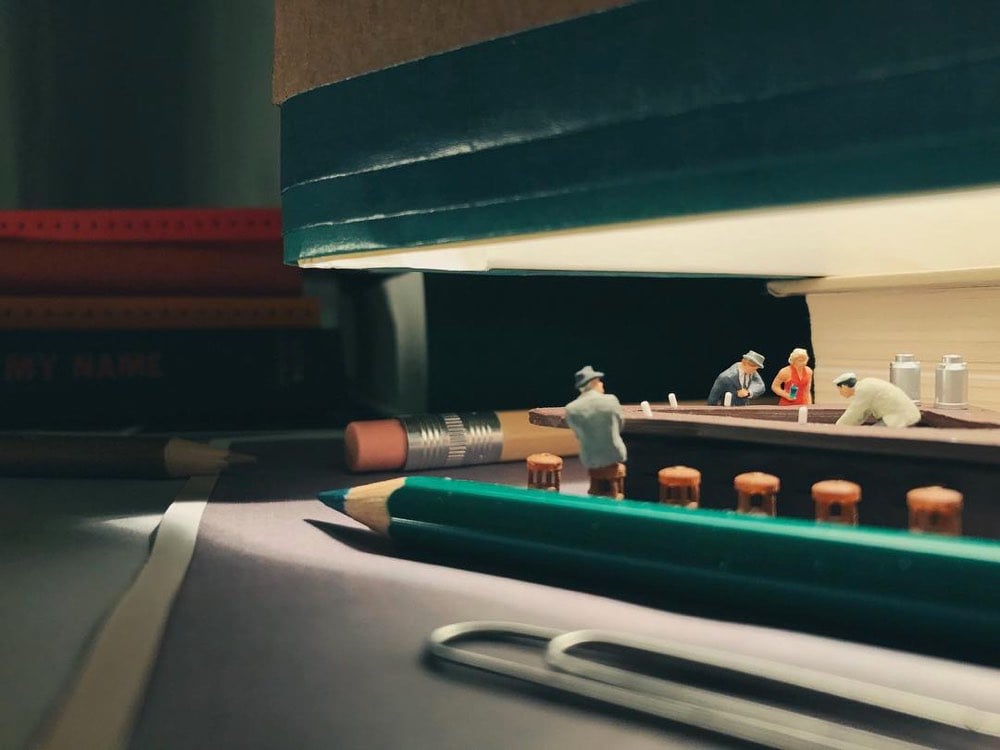


Using his iPhone 7, Derrick Lin pairs office supplies with tiny figurines to create these cool little scenes that he posts to Instagram. The book version of his photographic collection, Work, Figuratively Speaking, will be out in October. (via colossal)
Faces projected onto fabric tossed in the air
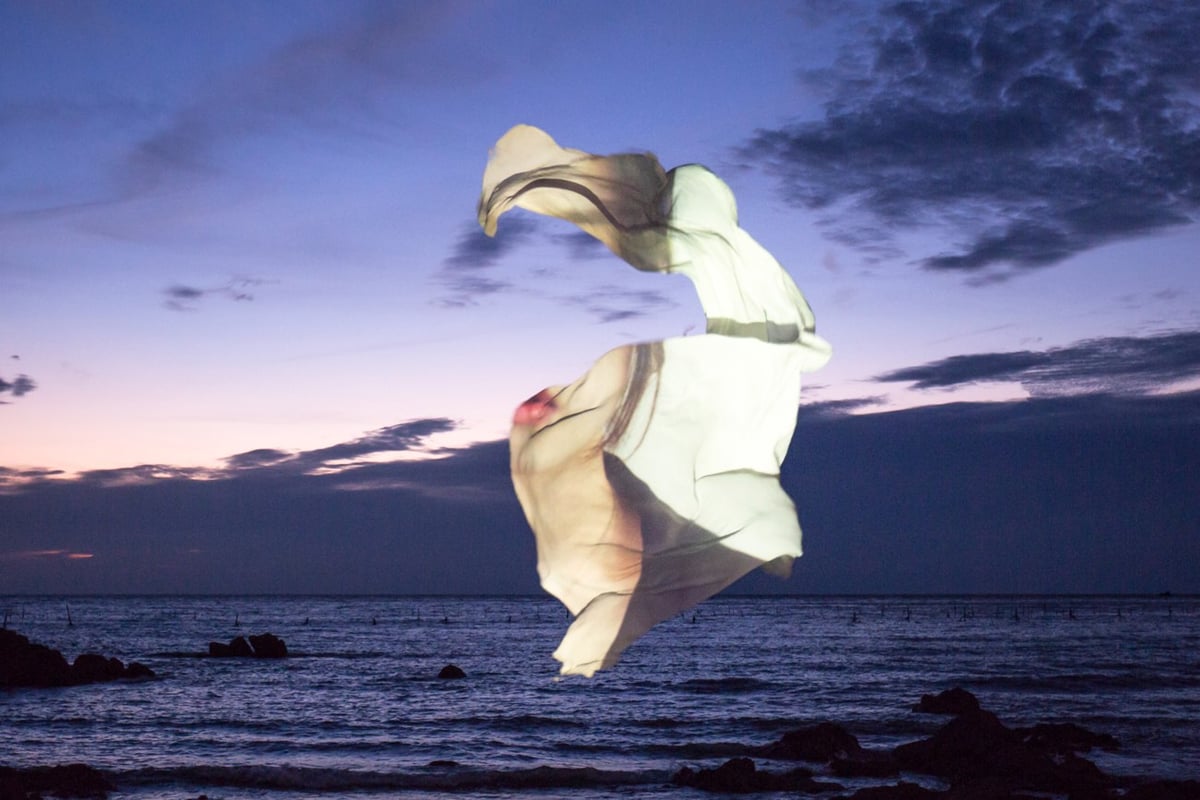
For his projected entitled Conversation, Wonjun Jeong tossed fabric into the air and projected images of faces on them.
The Vietnam War documentary series by Ken Burns
Together with Lynn Novick, filmmaker Ken Burns, who has previously made long documentary films on The Civil War and World War II, has made a film about perhaps the most controversial and contentious event in American history, The Vietnam War. The film runs for 18 hours across 10 installments and begins on September 17 on PBS.
David Kamp interviewed Novick and Burns for Vanity Fair and proclaims the film a triumph:
I watched the whole series in a marathon viewing session a few days before meeting with the filmmakers — a knock-you-sideways experience that was as enlightening as it was emotionally taxing. For all their unguarded anxiety about doing the war justice, Burns and Novick have pulled off a monumental achievement. Audiovisually, the documentary is like no other Burns-branded undertaking. Instead of folksy sepia and black-and-white, there are vivid jade-green jungles and horrific blooms of napalm that explode into orange and then gradually turn smoky black. The Vietnam War was the first and last American conflict to be filmed by news organizations with minimal governmental interference, and the filmmakers have drawn from more than 130 sources for motion-picture footage, including the U.S. networks, private home-movie collections, and several archives administered by the Socialist Republic of Vietnam. The series’s depiction of the Tet offensive, in which the North Vietnamese launched coordinated attacks on the South’s urban centers, is particularly and brutally immersive, approaching a 360-degree experience in its deft stitching together of footage from various sources.
The sound and music promises to thrill as well. Trent Reznor and Atticus Ross (who did the scores for The Social Network, Gone Girl, and The Girl with the Dragon Tattoo) provided original music to supplement popular music contemporary to the time. They even got The Beatles.
Then there’s all that popular music from the 60s and 70s: more than 120 songs by the artists who actually soundtracked the times, such as Bob Dylan, Joan Baez, the Animals, Janis Joplin, Wilson Pickett, Buffalo Springfield, the Byrds, the Rolling Stones, and even the ordinarily permissions-averse and budget-breaking Beatles. Of the Beatles, Novick noted, “They basically said, We think this is an important part of history, we want to be part of what you’re doing, and we will take the same deal everybody else gets. That’s kind of unprecedented.”
I’m very much looking forward to this.
Two hot dogs in a bun
This week-long food diary by author Alissa Nutting (Made for Love) is amazing. Nutting appears to subsist on little more than Red Bull and Cheeto dust. This four-paragraph stretch doesn’t even scratch the surface:
We’re staying in a remote cabin for a few days, getting some R&R between readings for my new novel and work events, so dinner is hot dogs. Two dogs per bun is my preferred meat-to-bun ratio. I was vegetarian and vegan for over 15 years, until a Nathan’s hot dog in Las Vegas sent me into a fatal processed-meat-love spiral that I don’t ever predict recovering from. I love processed meats and prefer hot dogs to steak.
I have a lot of calls to do this morning, so I pour a cold sugar-free Red Bull into a hot large coffee and gulp it. It tastes like lawn fertilizer, but its effectiveness is undeniable.
Breakfast and lunch are snacks between calls, classic red-bag Doritos and Cheetos and (for my health!) Oven-Baked Cheddar & Sour Cream Ruffles. I will eat almost anything coated in orange dust. I feel bad for my internal organs, but also really curious about what they must look like. I’ll donate my body to science when I die; I’m kind of obligated to. How many people get 92 percent of their food from vending machines?
Cheap beer is probably my favorite food, so when I finish my work, I devote the rest of the evening to all the delicious lowbrow northern beers that are hard to find near our home base in Iowa. There’s Grain Belt, which seriously has a blueberry-ghost-syrup aftertaste, and not for craft-brew reasons. I think it just has so much grain that it makes my pancreas hallucinate in a synesthetic way. When insulin dies, my body’s grief is apparently very fruit-flavored. There’s Labatt Blue and Labatt Blue Light (different pleasures), Molson Canadian Lager, Moosehead, and Miller Golden Light, which I purchase in 16-ounce-aluminum-bottle form because it feels the most recreational. For dinner, I pilfer calories each time I go to the fridge for a new cold one: cold cuts, pepperoni, Kraft American-cheese slices with mayo and mustard, and lots of peanuts.
I am genuinely intrigued by the two dogs in a bun thing but American singles with mayo and mustard? Yoloooooo.
Huge trove of digitized 78rpm records

Through the Great 78 Project, the Internet Archive has been digitizing the audio from 78rpm records produced from 1898 to the 1950s. Over 25,000 high-quality recordings are currently available from artists like Edith Piaf, Irving Berlin, Lena Horne, and Duke Ellington. This preservation is important because the discs are fragile:
78s were mostly made from shellac, i.e., beetle resin, and were the brittle predecessors to the LP (microgroove) era. The format is obsolete, and just picking them up can cause them to break apart in your hands. There’s no way to predict if the digital versions of these 78s will outlast the physical items, so we are preserving both to ensure the survival of these cultural materials for future generations to study and enjoy.
From 1939, here’s Judy Garland singing Over the Rainbow. And this undated recording of Edith Piaf singing La Vie En Rose. I could listen to these all afternoon.
Hilarious robot-generated Pepsi logo t-shirts

Oh, I love these algorithmically generated Pepsi logo t-shirts. I think TURNIPS is the least refreshing tasting cola beverage possible (ok, maybe SHRIMP FRIED RICE) but I ordered a LETTUCE shirt for myself just for the hell of it. Eager to see if it actually arrives as pictured. (via @cabel)
Yes, barbed wire fenced cows but also provided telecommunications
Barbed wire is one of the most important inventions of the past 150 years. It tamed the Wild West and solidified the concept of land ownership in America. Tim Harford, author of Fifty Inventions That Shaped the Modern Economy, writes:
After Europeans arrived and pushed west, the cowboys roamed free, herding cattle over the boundless plains.
But settlers needed fences, not least to keep those free-roaming cattle from trampling their crops. And there wasn’t a lot of wood — certainly none to spare for fencing in mile after mile of what was often called “The American Desert”.
Farmers tried growing thorn-bush hedges, but they were slow-growing and inflexible. Smooth wire fences didn’t work either — the cattle simply pushed through them.
Barbed wire changed what the Homestead Act could not.
Until it was developed, the prairie was an unbounded space, more like an ocean than a stretch of arable land.
Private ownership of land wasn’t common because it wasn’t feasible.
With demand came fierce competition; there were dozens of different types of barbed wire:
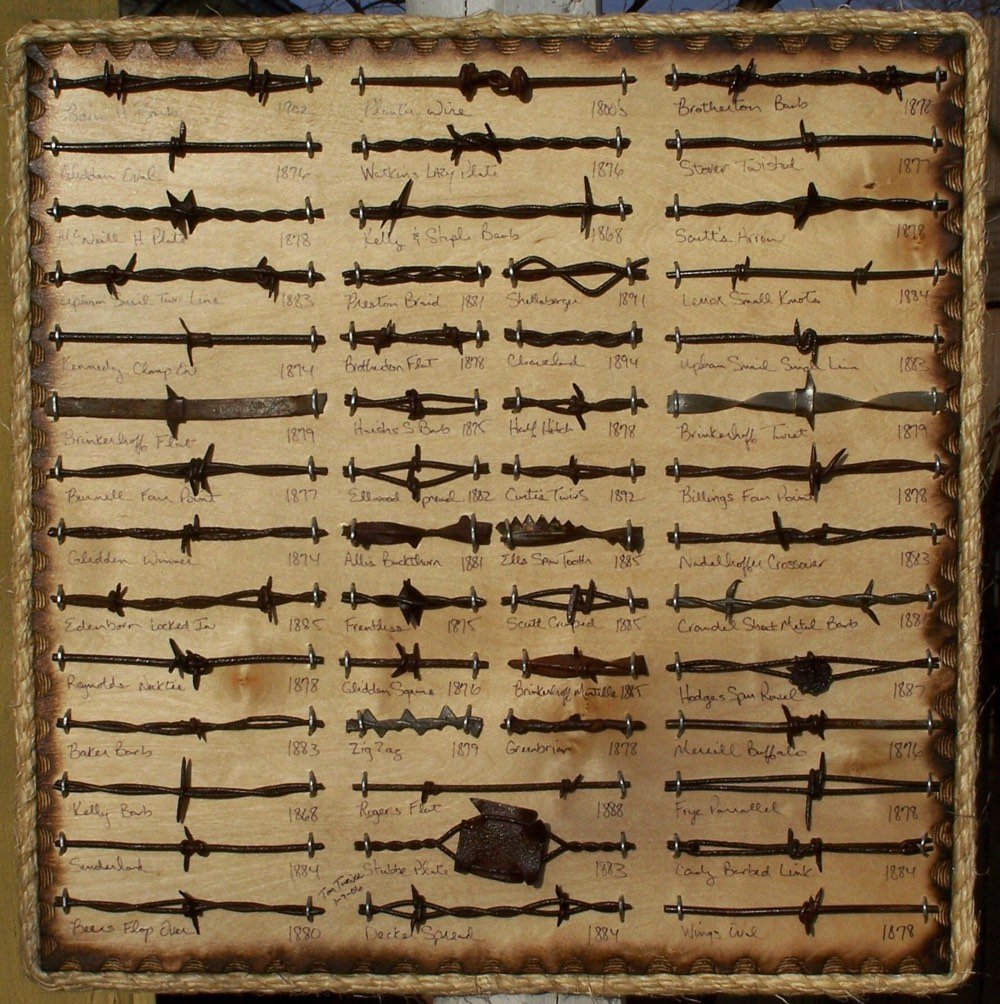
Just two years after Joseph Glidden patented his design for barbed wire in 1874, another of the 19th century’s great inventions burst onto the scene in the form of Alexander Graham Bell’s telephone. The two world-changing technologies would combine in a surprising way in the western United States. Because of the expense of running dedicated telephone services over long distances, some farmers opted to run their telecommunications over the hundreds of thousands of miles of barbed wire criss-crossing the land.
So cool. I’m reading A Mind at Play right now. It’s a biography of Claude Shannon, “the architect of the information age”. As a boy, Shannon wired the half-mile stretch of barbed wire fence between his family’s farm and a friend’s house:It was in building the network connecting homestead to homestead that the farmers’ ingenuity came to the fore. Instead of erecting new poles and wires, many either ran phone wires along the top of wooden fence posts or used the barbed wire itself to carry signals. The latter hardly worked as well as insulated copper wire, but with the lines already in place, installation and operating costs could be kept to a minimum. By one estimate, service ran a mere $3 to $18 a year, far less than the regional phone companies charged, and labor for maintaining the network was supplied by volunteers.
He charged it himself: he hooked up dry-cell batteries at each end, and spliced spare wire into any gaps to run the current unbroken. Insulation was anything at hand: leather straps, glass bottlenecks, corncobs, inner-tube pieces. Keypads at each end — one at his house on North Center Street, the other at his friend’s house half a mile away — made it a private barbed-wire telegraph. Even insulated, it is apt to be silenced for months in the ice and snow that accumulate on it, at the knuckle of Michigan middle finger. But when the fence thaws and Claude patches the wire, and the current runs again from house to house, he can speak again at lightspeed and, best of all, in code.
In the 1920s, when Claude was a boy, some three million farmers talked through networks like these, wherever the phone company found it unprofitable to build. It was America’s folk grid. Better networks than Claude’s carried voices along the fences, and kitchens and general stores doubled at switchboards.
(via mr)
Update: See also the Devil’s Rope episode of 99% Invisible. (thx, dave)
People are awesome, even in 2017
Big flips, fast bikes, flipping sticks, leaping gaps, elephant tricks, big airs, quick climbs, trick shots, Superman on a bike, and a guy who looks a lot like Fred Rogers waterskiing on his back. I think we all need a reminder these days of how amazing people can be when they put their minds and hearts into it. Give this video 10 seconds of your time and I guarantee you’ll end up watching the whole thing with a goofy grin on your face.
X-ray maps of NYC subway stations


The subway and the street level of NYC are two very different worlds and even long-term residents have a difficult time understanding how they fit together. Architect Candy Chan has drawn a series of x-ray maps of NYC subway stations that show their layouts and orientation compared to the geography of the streets above. (Tip: you can zoom the maps for more detail.)
The series is an extension of her station layouts series. Prints are available in Chan’s shop.
Obama, An Intimate Portrait by White House photographer Pete Souza
For all eight years of Barack Obama’s Presidency, Pete Souza was Chief Official White House Photographer and took over 2 million photos of the President and his activities in office. Souza has collected some of those photos into a book: Obama: An Intimate Portrait, out in November.
Obama: An Intimate Portrait reproduces Souza’s most iconic photographs in exquisite detail, more than three hundred in all. Some have never been published. These photographs document the most consequential hours of the Presidency — including the historic image of President Obama and his advisors in the Situation Room during the bin Laden mission — alongside unguarded moments with the President’s family, his encounters with children, interactions with world leaders and cultural figures, and more.
It’s impossible to pick a favorite photo of Souza’s, but these two are right near the top:

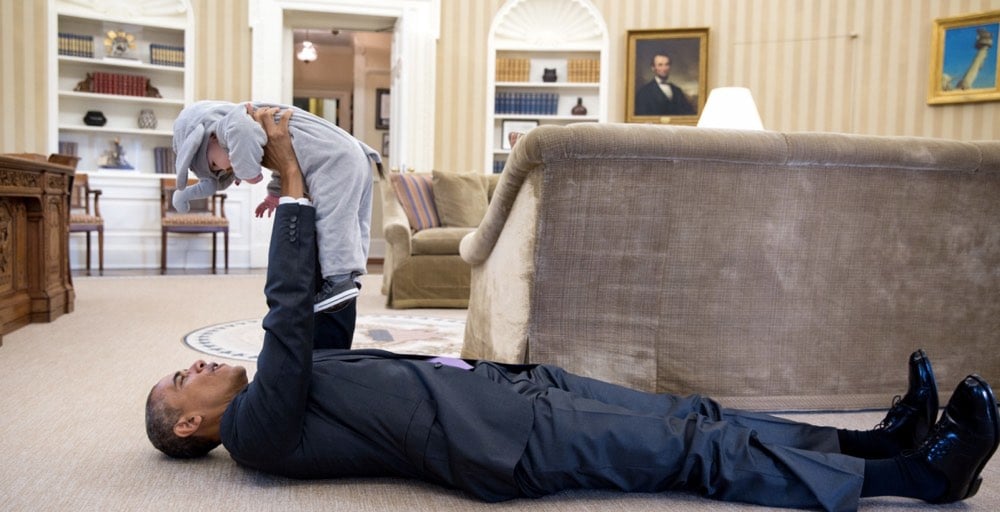
What’s Souza up to these days? Trolling the current inhabitant of the White House on Instagram, as you do.
A graph of global temperature anomalies from 1900-2016
Using NASA’s GISTEMP data (a measure of the surface air temperature around the world), climate researcher Antti Lipponen put together this data visualization of global temperature anomalies from 1900-2016. Until about the mid-90s, the lines in different parts of the world pulse blue (cooler) or yellow/red (warmer) each year as regional climate varies…but it slowly turns less blue and more yellow. From 1997 on, the thing is basically an angry red porcupine.
New work from Cindy Sherman (on Instagram?!)

Artist Cindy Sherman has had a private Instagram account for some time but suddenly made it public the other day. Scrolling back through the archives, it becomes apparent that Sherman has been playing around with new techniques for altering her appearance, constructing an online exhibition of sorts in the process.
For an artist whose practice is based almost entirely on how she presents herself, Sherman has managed to remain camera-shy in her life outside of the studio. Yet, in a surprising move, the photographer has recently taken to Instagram to share images of herself that echo photographs typically reserved for gallery walls. Not only does this provide a generous look into her process for her fans, it also raises the question: Is Cindy Sherman using Instagram to make new work?
The Hidden Rhythm in Radiohead’s “Videotape”
In her first installment for a new Vox series called Earworm, Estelle Caswell takes a look at some weird musical stuff happening with Videotape, a song off of Radiohead’s In Rainbows. According to a longer video by Warren Lain referenced by Caswell, Radiohead has hidden a syncopated rhythm in the song that even the band members have trouble keeping straight when they’re trying to play it. Videotape is my favorite song on that album…maybe this is a reason why?
Also, don’t miss the short explanation of how “rhythmic sound synchronizes the brain waves of groups of people”. !!!
The art of making classic/pop music mashups
I’ve mentioned Steve Hackman here before; he’s a composer who arranges and conducts mashups of music from classical and contemporary musicians. He’s done performances of Beethoven vs Coldplay, Brahms vs Radiohead, and several others. I’ve been eagerly awaiting the video for the full performance of Drake vs Tchaikovsky…but no dice yet.
Hannah Yi from Quartz recently talked to Hackman about how he goes about creating these mashups by looking for similarities in meter, chords, and emotion between two pieces of music.
From age 15 to 90, the evolution of Picasso’s style through 14 self-portraits


Pablo Picasso painted his first self-portrait in 1896 (top), when he was 15 years old. Many styles, years, and artistic innovations later, he made one of his last in 1972 at the age of 90 (bottom)…it was called Self-Portrait Facing Death. Open Culture has a look at how Picasso’s portrayal of himself changed over his long and productive life.
The severe youth of 15, further up, brooding, world-weary, and already an accomplished draughtsman and painter; the grimly serious romantic at 18, above — these Picassos give way to the wide-eyed maturity of the artist at 56 in 1938, at 83, 89, and 90, in 1972, the year before his death. That year he produced an intriguing series of eclectic self-portraits unlike anything he had done before.
10 hidden clues you never noticed in classic movies
Directors sometimes like to hide clues about a movie’s plot (or even ending) in the background of earlier scenes, a practice that rewards repeat viewing. Some examples cited in this video are from The Shining, Reservoir Dogs, Psycho, and The Usual Suspects. I’ve seen The Shawshank Redemption several times, and I never picked up on the hidden meaning of Red’s admonishment of Andy’s plan as “shitty pipe dreams”. (via film school rejects)
In a Heartbeat
In this short animated film, a boy’s heart brings him closer to the boy he has a crush on. What a lovely little video. It was made by Ringling College of Art and Design students Beth David and Esteban Bravo as their computer animation thesis and funded via Kickstarter.
Trailer for Narcos season three
With Pablo Escobar out of the picture, the third season of Narcos focuses on the activities of the Cali drug cartel. It’ll be interesting to see if the show holds up as well without Wagner Moura, who was fantastic as Escobar. And was that Halt and Catch Fire’s Kerry Bishé I saw briefly in the trailer? (Narrator: It was.) The new episodes will be available on Netflix September 1st.
The Bulwer-Lytton Fiction Contest winners for 2017
Each year, in honor of English novelist Edward Bulwer-Lytton, who once began a novel “It was a dark and stormy night”, the Bulwer-Lytton Fiction Contest attracts hundreds of entrants who attempt to craft the worst opening sentence to an imaginary novel. Kat Russo won the 2017 contest with this line:
The elven city of Losstii faced towering sea cliffs and abutted rolling hills that in the summer were covered with blankets of flowers and in the winter were covered with blankets, because the elves wanted to keep the flowers warm and didn’t know much at all about gardening.
I was also fond of this one, by Anna MacDougald:
There’d been six of us at the outset, but after Smythe took a poisoned dart to the chest, Buddlestone fell from the top of a cliff, Stevens and Mayhew were swallowed by quicksand, and Tait-Harris was eaten by ants, only I remained to bring you our amazing tale.
See also Charles Morris’ 10 Winning Intros to Solve That Boring Cover Letter:
1. “The Confederacy’s biggest problem was messaging.”
9. “A train is traveling at 100 mph. A child is tied to the track. I have a switch in front of me. If I pull it, the train will switch to another track, and instead of hitting the child it will hit ten convicted felons. What do I do? Trick question: I’m not even there. I’m at your company helping you make record profits.”
On/Off
With each beat of the metronome in this visually striking and inventive video of a skateboarder, the scene switches from day to night and back again. It’s not a complicated effect but combined with the simple electronic beat, it is mesmerizing.
The winners of the 2017 National Geographic Travel Photographer of the Year contest
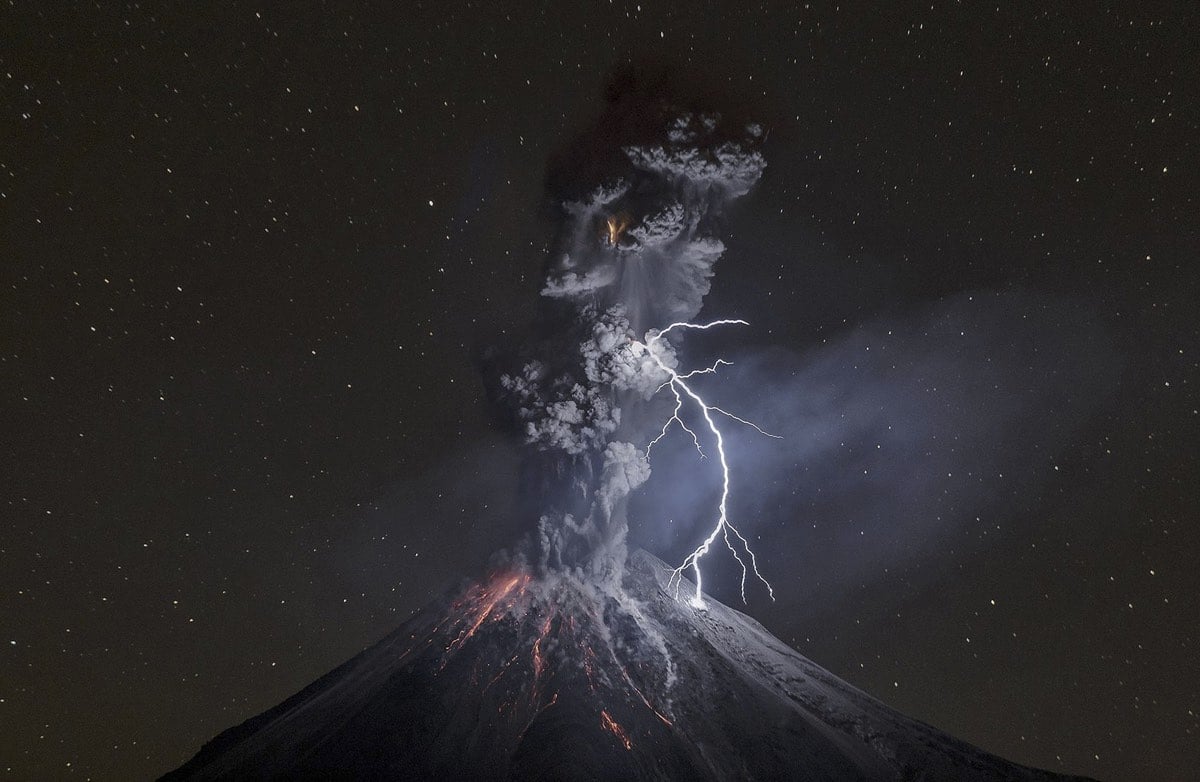


In Focus is sharing some of the photographs taken by the winners of the 2017 National Geographic Travel Photographer of the Year contest. The winning photo, of Mt. Doom the Colima volcano in Mexico, was taken by Sergio Tapiro Velasco, who will receive a 10-day trip for 2 to the Galapagos islands for his efforts. The second photo above was taken by Andrzej Bochenski and the third by Julius Y.
Voronoi diagram of people enjoying a park

Starting with an overhead shot of people sitting out in the sun in NYC’s Bryant Park, Rod Bogart laid what’s called a Voronoi diagram on top of it. A Voronoi diagram is a way of mapping out areas where any point in a given area is closer to a seed point than it is to any other seed point. You can think of it as a sphere of influence…and in this case, you can see how the park-goers have organized themselves into having their own personal space. As Bogart says:
It’s fascinating to see the real world optimization problem of wanting to get a nice large patch of grass.
I often think about Voronoi diagrams when I get into an elevator.
I stand alone in the elevator, right in the middle, equidistant from the four walls. Before the doors close, a woman enters. Unconsciously, I move over to make room for her. We stand side by side with equal amounts of space between the two of us and between each of us and the walls of the elevator. On the 12th floor, a man gets on and the woman and I slide slightly to the side and to the back, maximizing the space that each of us occupies in the elevator. At the 14th floor, another man gets on. The man in front steps to the back center and the woman and I move slightly toward the front, forming a diamond shape that again maximizes each person’s distance from the elevator walls and the people next to them.
See also “the human ellipse”.
Landing the hardest trick after 2 years of trying
Over a period of two years, skateboarder Christian Flores fell down thousands of times, broke boards, went to the hospital twice, and cracked a rib trying to do a laser flip down a triple set of stairs.
Even if you don’t care about skateboarding, watching Flores try and fail over and over and over and over (and over) again should be familiar to anyone who has ever attempted to master something difficult.
mother!
Darren Aronofsky (Requiem for a Dream, The Wrestler) is coming out with a new film in September called mother! It’s a “psychological horror-thriller” starring Jennifer Lawrence and Javier Bardem. The score is by Jóhann Jóhannsson, who did the excellent score for Arrival, and not by Clint Mansell, Aronofsky’s long-time collaborator.
Browse the British Library’s online copy of Leonardo da Vinci’s 570-page notebook
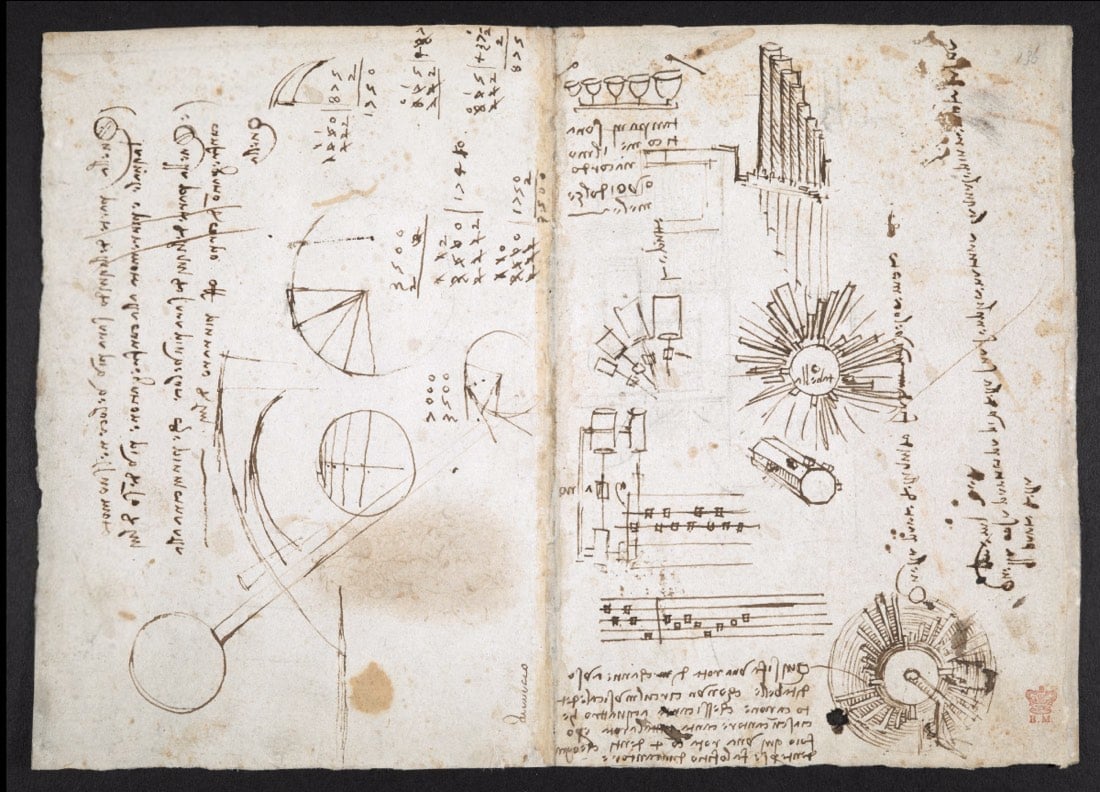

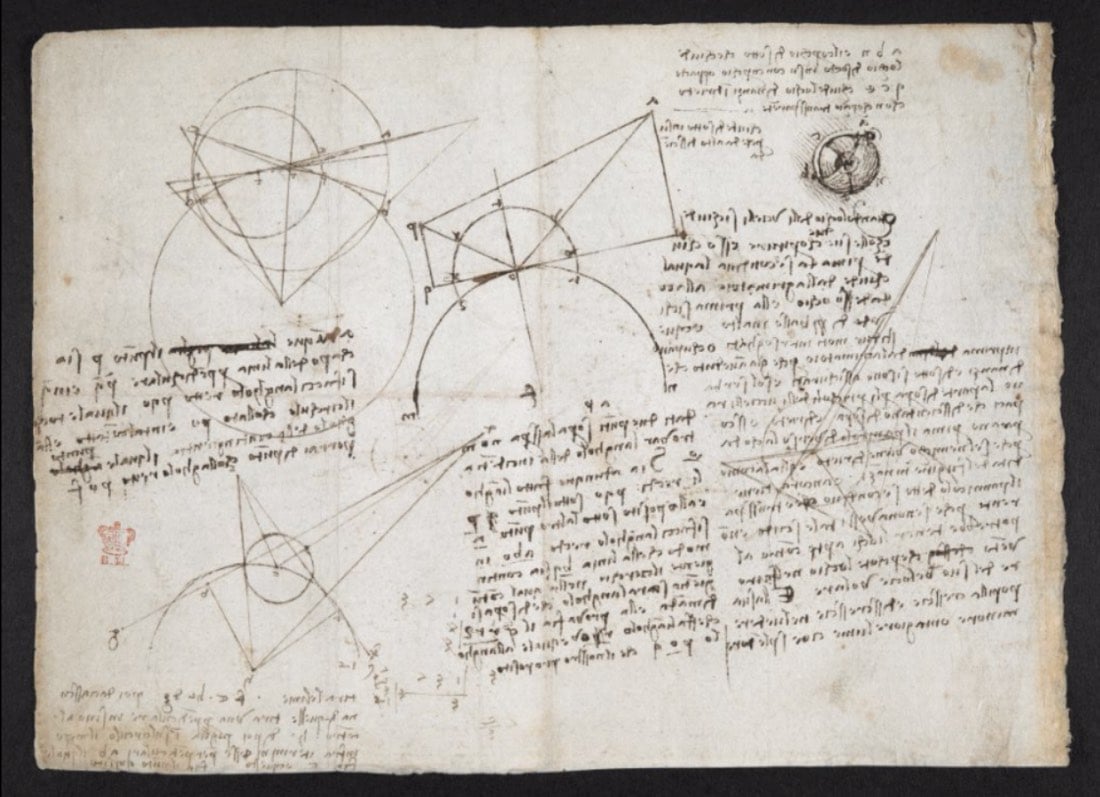
Leonardo da Vinci was an avid taker of notes. Over the course of his working life, he filled thousands of pages with drawings, sketches, equations, and his distinctive mirrored handwriting. The British Library has one of Leonardo’s notebooks and has digitized and put all 570 pages of it online. It’s interesting to see all of the spare geometric line drawings and then every once in awhile there’s this wonderfully rendered 3D-shaded tiny masterpiece in the margin when more detail was required. (via open culture)
Buildings photographed to look like spaceships


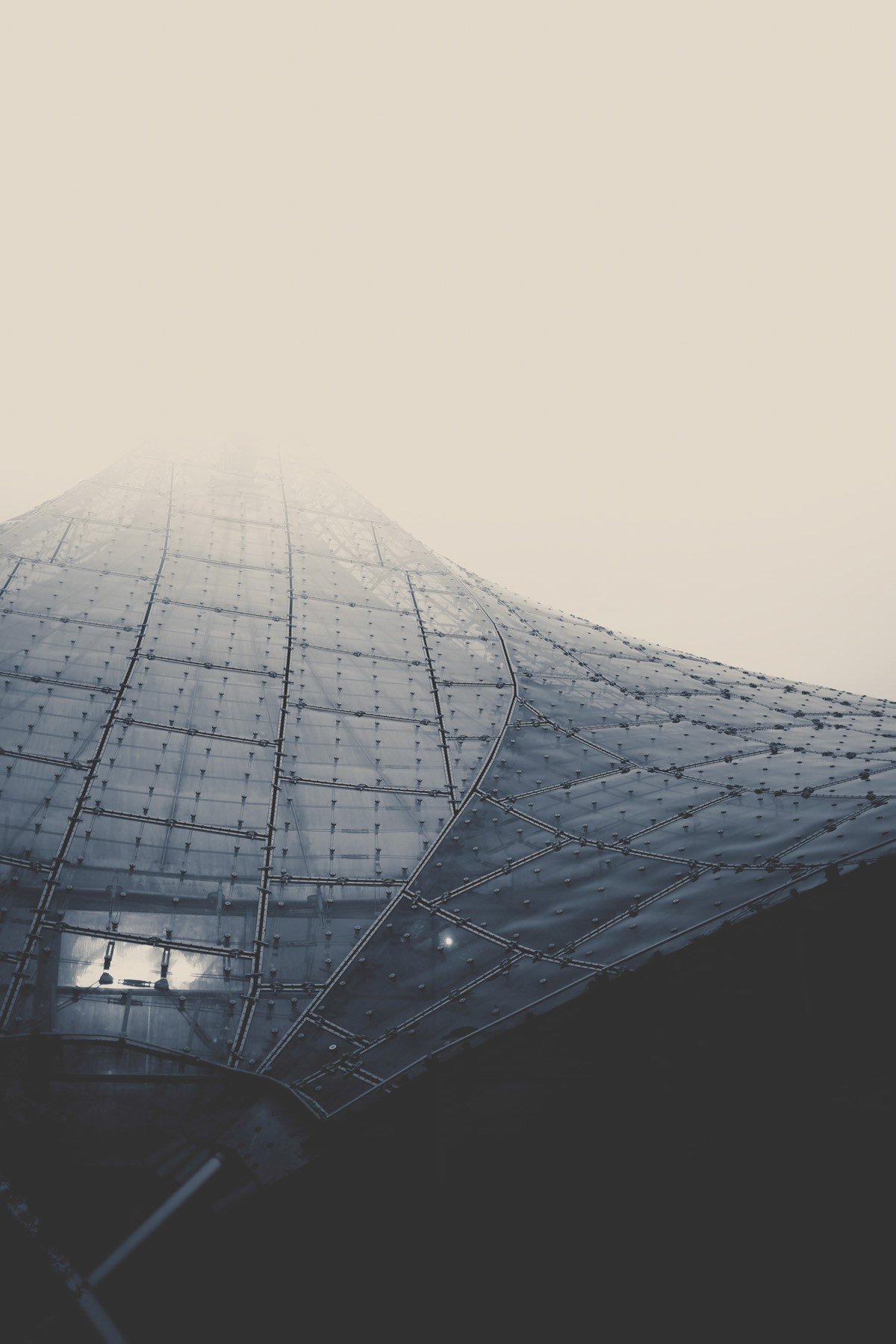
For his series entitled Spaceships, photographer Lars Stieger took photos of architectural structures that look like futuristic spaceships. (via colossal)
The world’s first fidget spinner, circa 2000 BCE
Arielle Pardes posted this image of a baked clay sculpture/figurine that is the spitting image of a fidget spinner.

“Spinning Toy with Animal Heads” is from Tell Asmar in Iraq, former site of the ancient Sumerian city of Eshnunna, dates from 2000-1800 BCE, and is currently housed at the Oriental Institute of the University of Chicago.
A lovely and poignant story of two friends, documented through photos, journal entries, and drawings
Trailer for Transparent season four
Transparent, aka my favorite TV show of the last few years, is back for a fourth season on September 22.
The Pfeffermans take off on a spiritual and political journey as they dig deep into their family’s history. Maura heads to Israel to speak at a conference and makes a startling discovery. Adrift in the desert, Maura, Ali, Sarah, Josh and Shelly set off on their own paths to find acceptance, love, and truth.
My five favorite video games of all time
This tweet asking people to list their top five video games of all time is going a little viral. I am very much not a “gamer” — mostly because if I were, I would never get anything else done — so I can’t produce anything like a These Are the Finest Games of the Early Age of Video Games list, but I can share the list of games that I’ve most enjoyed playing over the years.
1. Lode Runner (PC, 1983). Growing up, we didn’t have a Pong console or an Atari like some of my friends and cousins did, but when my parents divorced, my dad bought the first IBM-compatible computer that came out. And one of the few games we had for it was Lode Runner. The game was a blast, but what really put it over the top was the ability to make your own levels. Now that I think about it, that the first video game I ever obsessed over included a built-in level designer maybe primed me for falling in love with the web at first sight. View source?! Uh, yes please.
2. The Legend of Zelda (NES, 1986). Legendary…it’s right there in the name. I played this game so much. One of my finest video game achievements is finishing Zelda using only the wooden sword. Close runners-up: Super Mario Bros (NES) and Tetris on the Game Boy, which I played perhaps more than Zelda and SMB combined. So many batteries.
3. NHL ‘94 (Sega Genesis, 1993). Out of all the games I’ve ever played, I had the most fun playing NHL ‘94 with my friends and floormates in college. We’d play for hours on end, especially during the winter months, people drifting in and out to go to class. I don’t know how I managed to not flunk out of school that year. Runner-up: Tecmo Super Bowl (NES). Everyone had their favorite teams/players, but I was almost unstoppable with Philadelphia and their quarterback, QB Eagles (they couldn’t use Randall Cunningham’s name due to licensing issues).
4. Mario Kart Wii (Wii, 2008). This was a tough one. Mario Kart Wii was not my first Kart nor the best I’ve played (Mario Kart 8 has superior gameplay IMO) and almost no game was more fun than playing 8-player Mario Kart Double Dash with two linked GameCubes in the same tiny NYC apartment. But the Wii version was the first one in which you used an actual freaking steering wheel to pilot your Kart around.
5. Alto’s Adventure (iOS, 2015). I’ve written about Alto’s Adventure before:
At first, I played because the game was fun and I wanted to beat it. But eventually, I started playing the game when I was stressed or anxious. It became a form of meditation for me; playing cleared my mind and refocused my attention on the present. Even the seemingly stressful elements in the game became calming. The Elders, who spring up to give chase every few minutes, I don’t even notice anymore…which has become a metaphorical reminder for me to focus on my actions and what I can control and not worry about outside influences I can’t control.
It’s not an exaggeration to say that Alto’s Adventure helped me work through some of my shit almost as much as seeing a therapist for almost 2 years. Runners-up: Kingdom Rush and Drop7, both of which I played a lot but neither saved my sanity, so…
A few honorable mentions: Quake 3, Bubble Bobble (which I never played in the arcade or on Nintendo but discovered later on MAME), Wii Sports, Metroid, Dune II, Minecraft (I haven’t actually played it that much, but I love watching my kids play), SMB 2, SMB 3, Baseball Stars, and, uh, Cookie Clicker.




Stay Connected